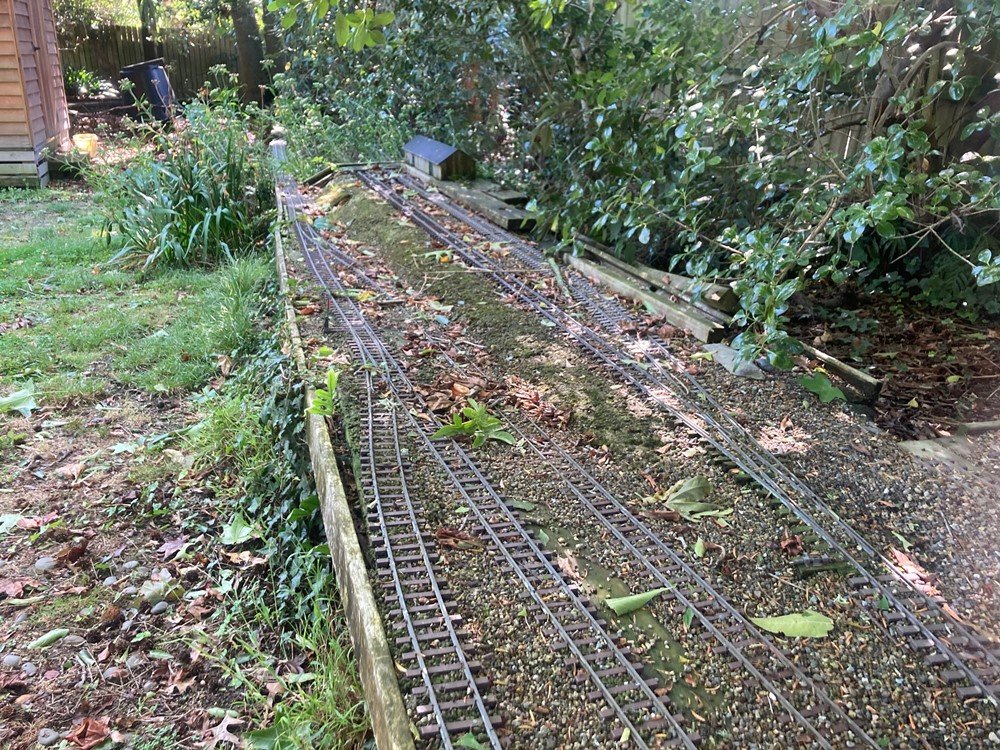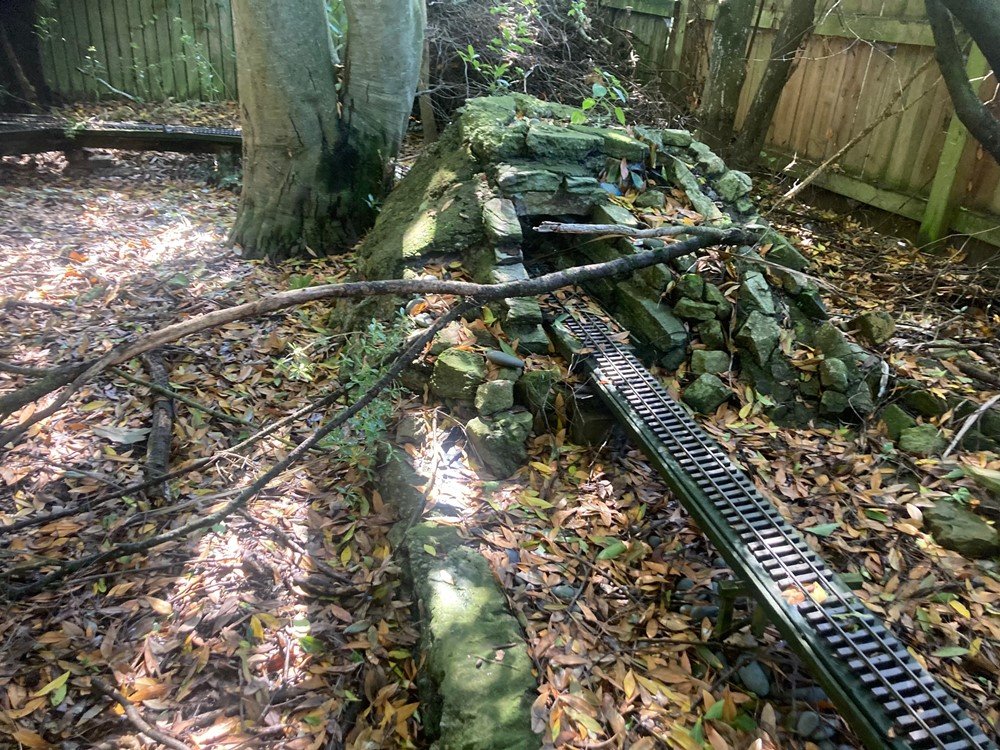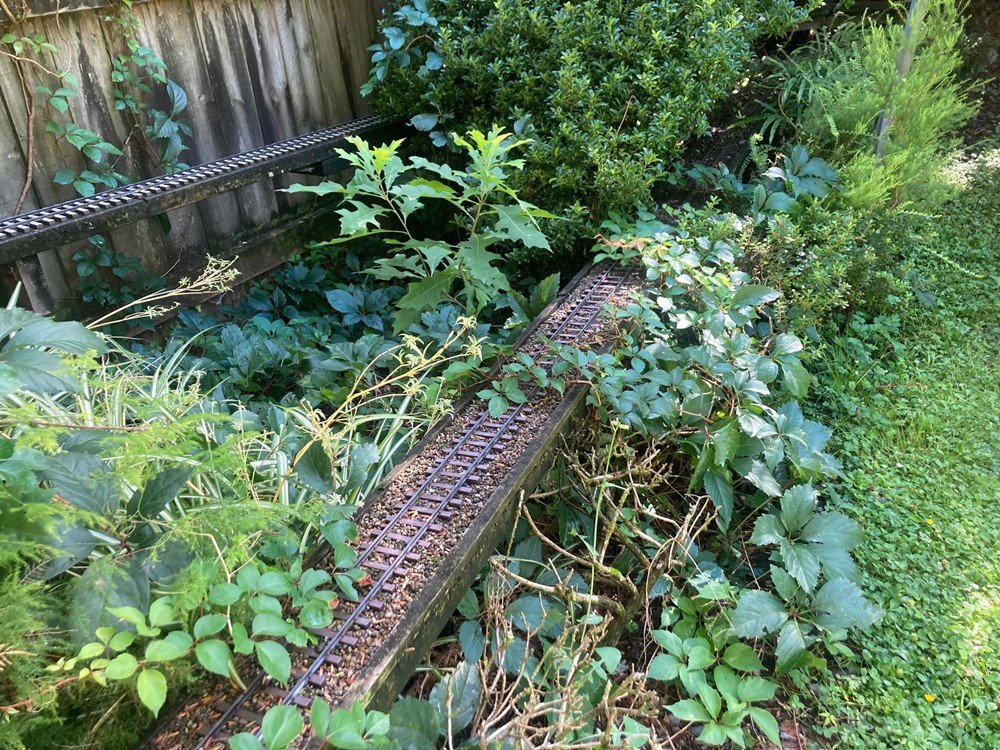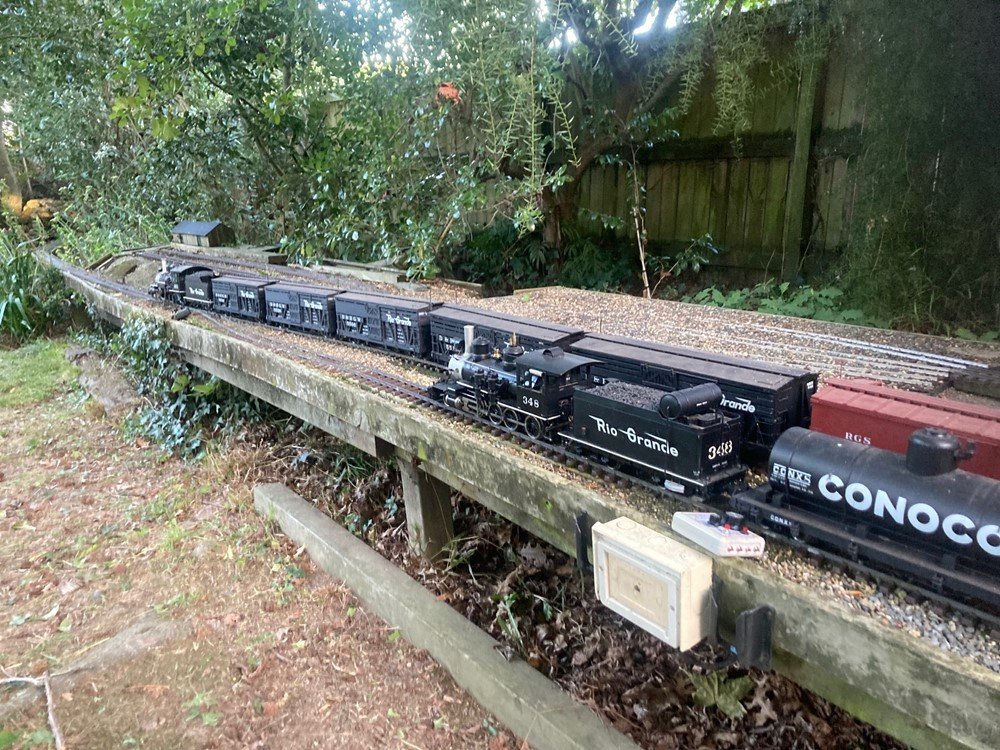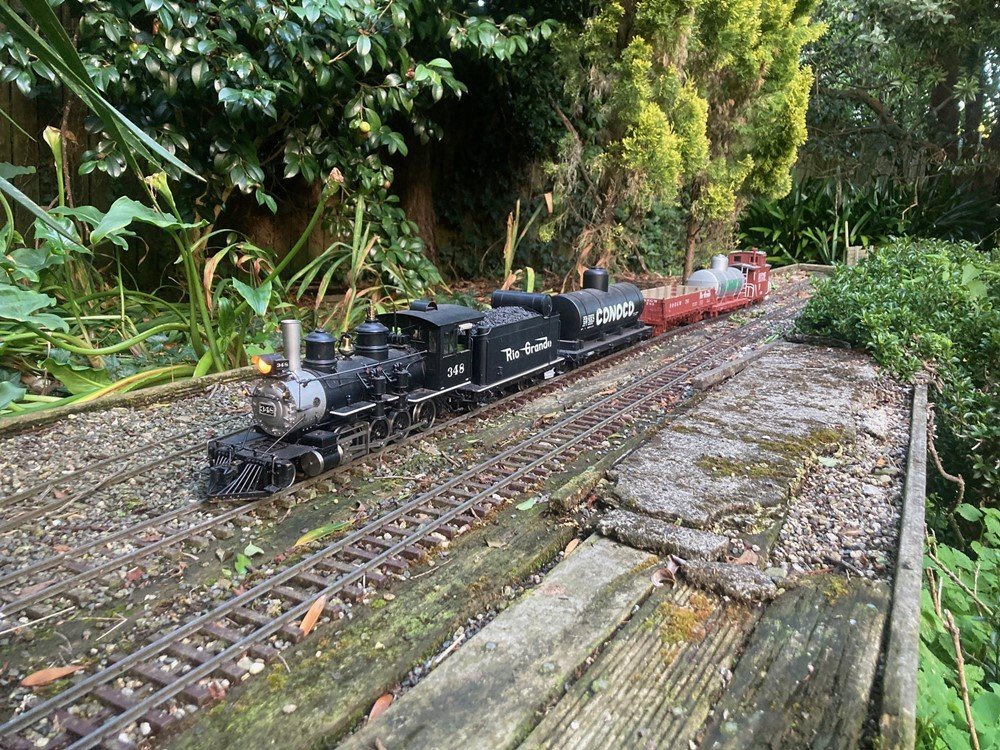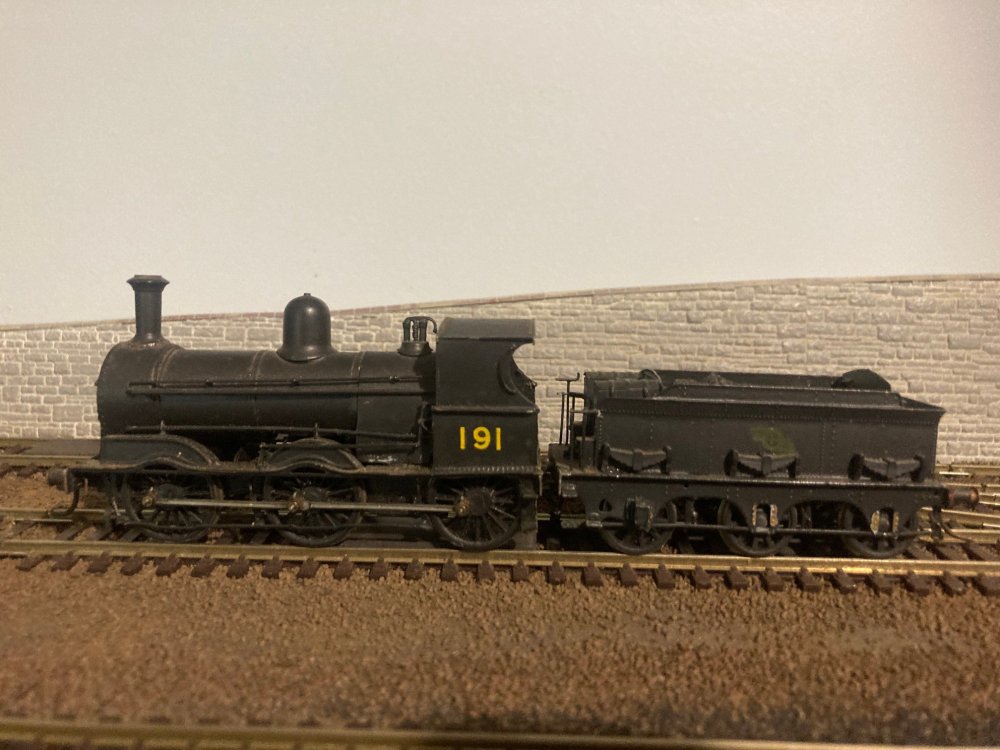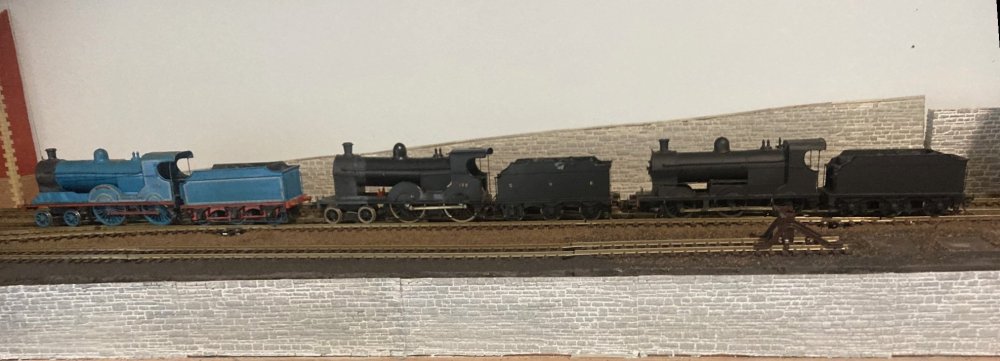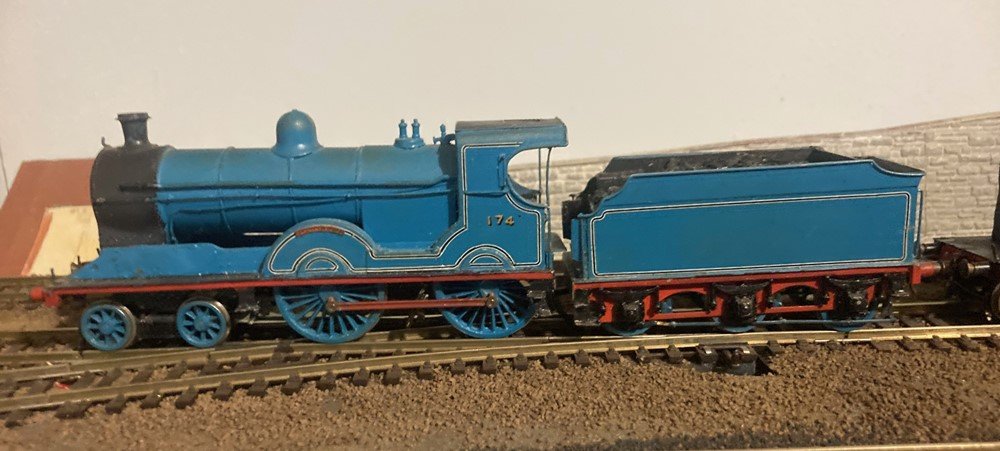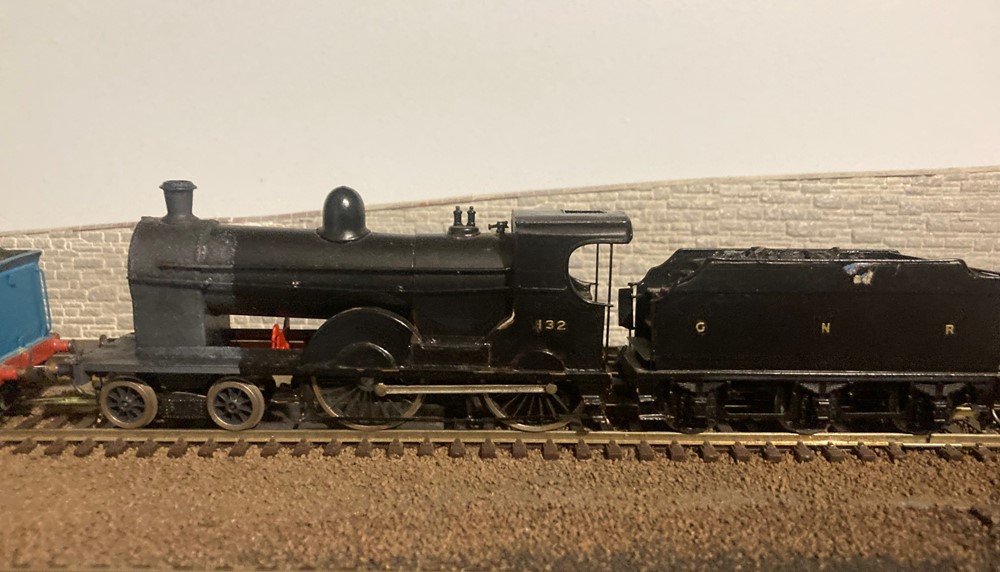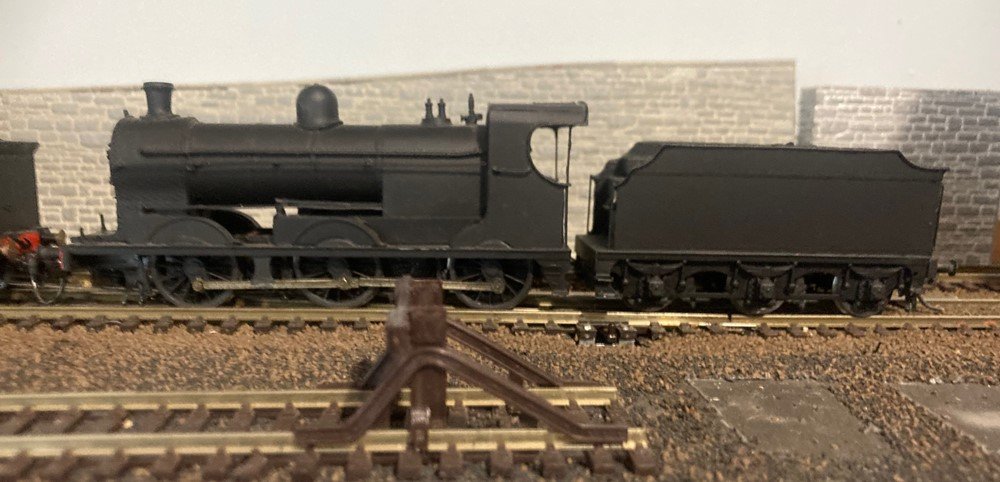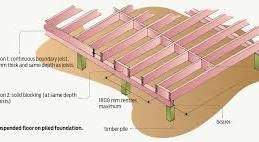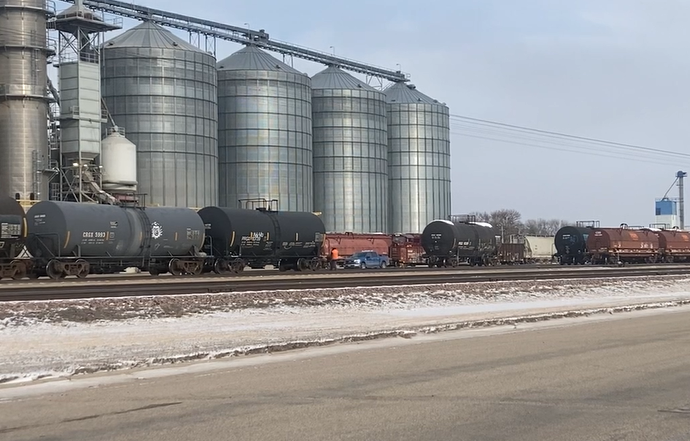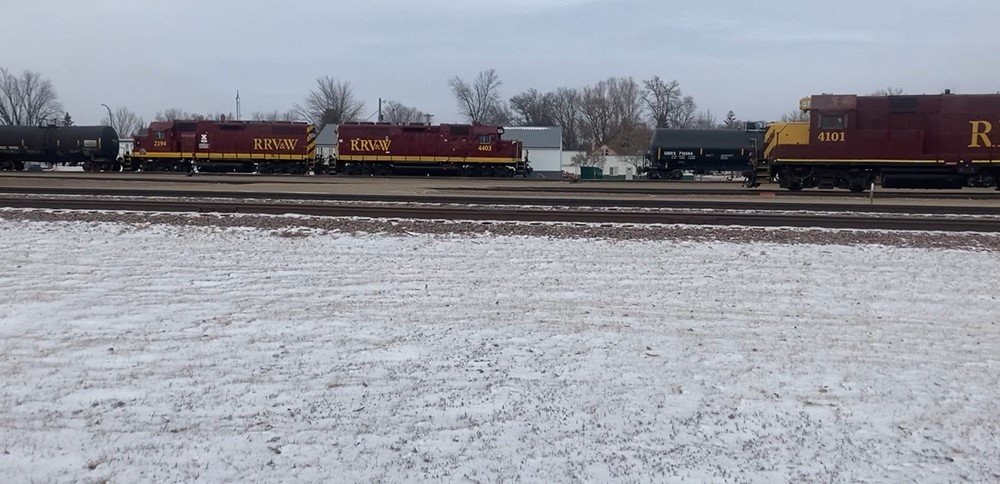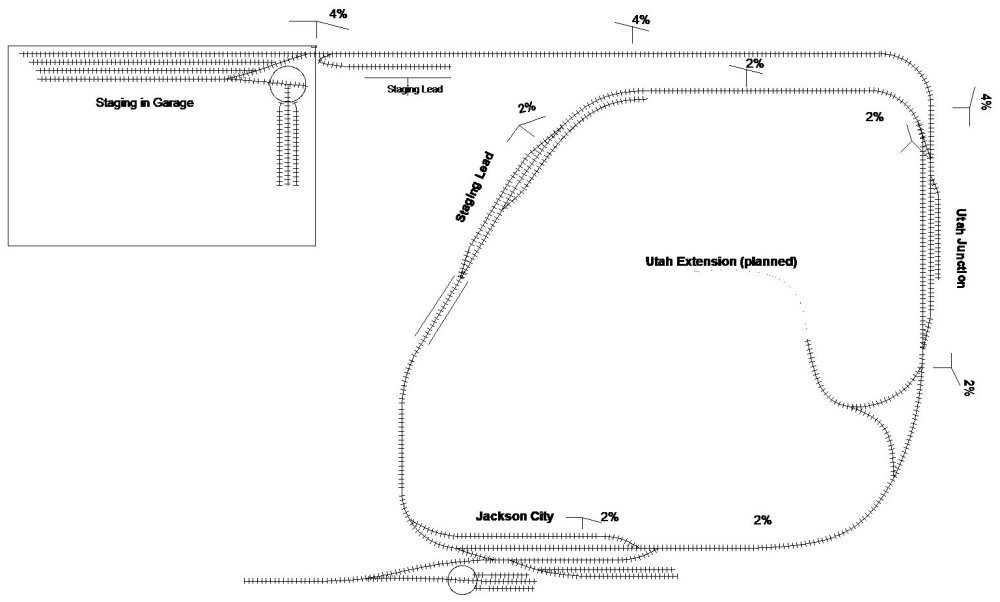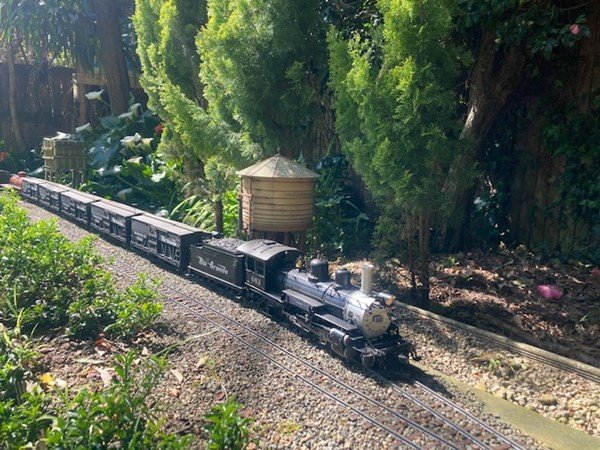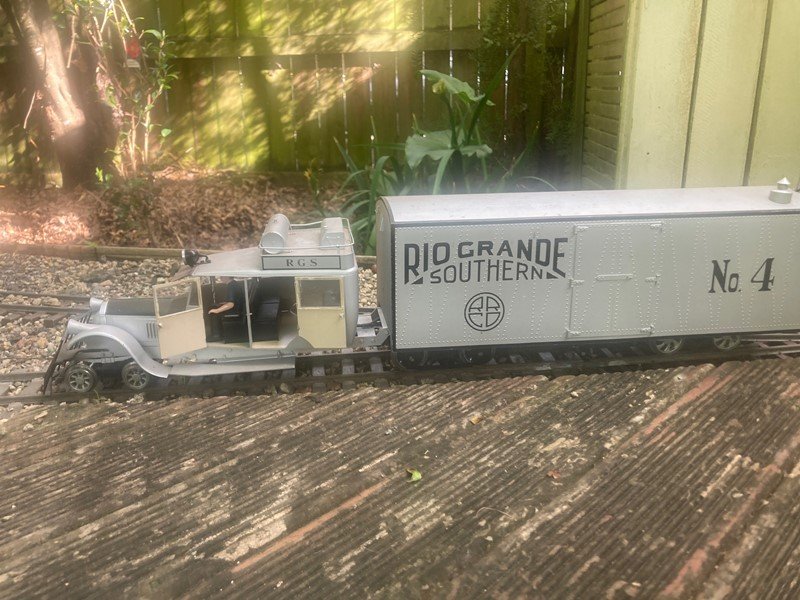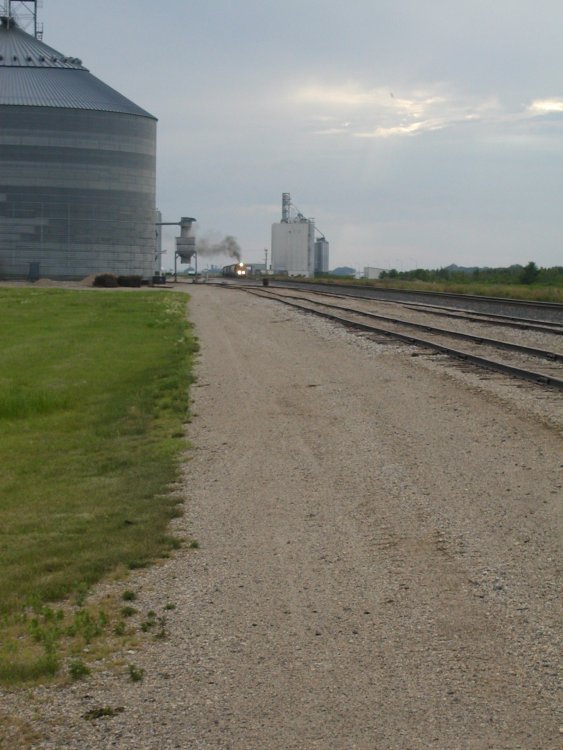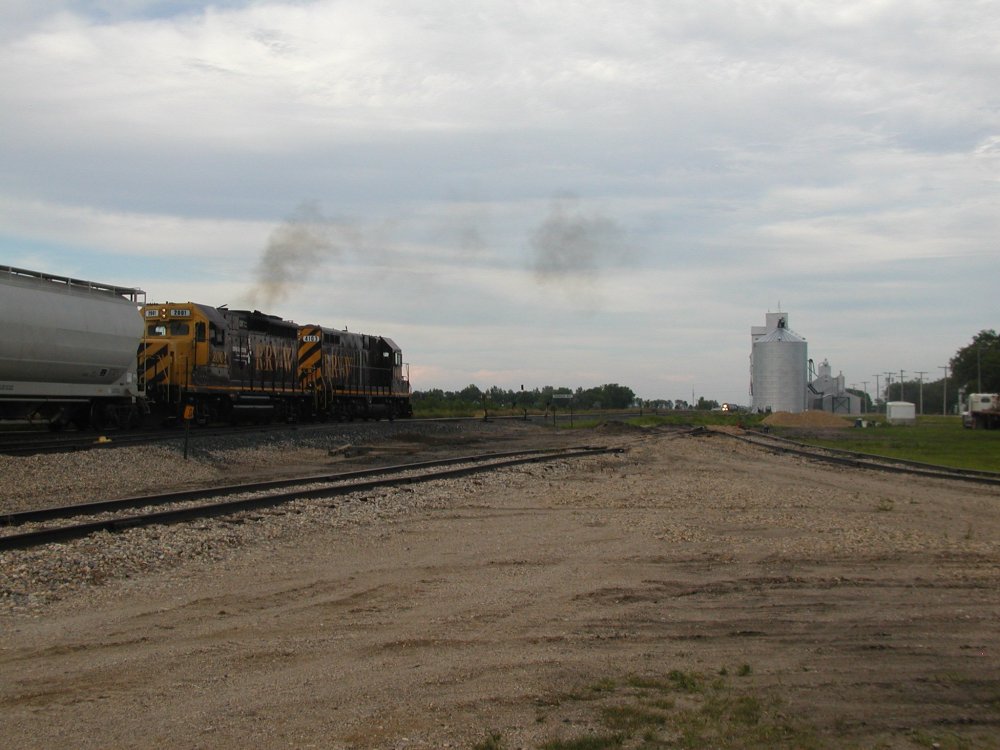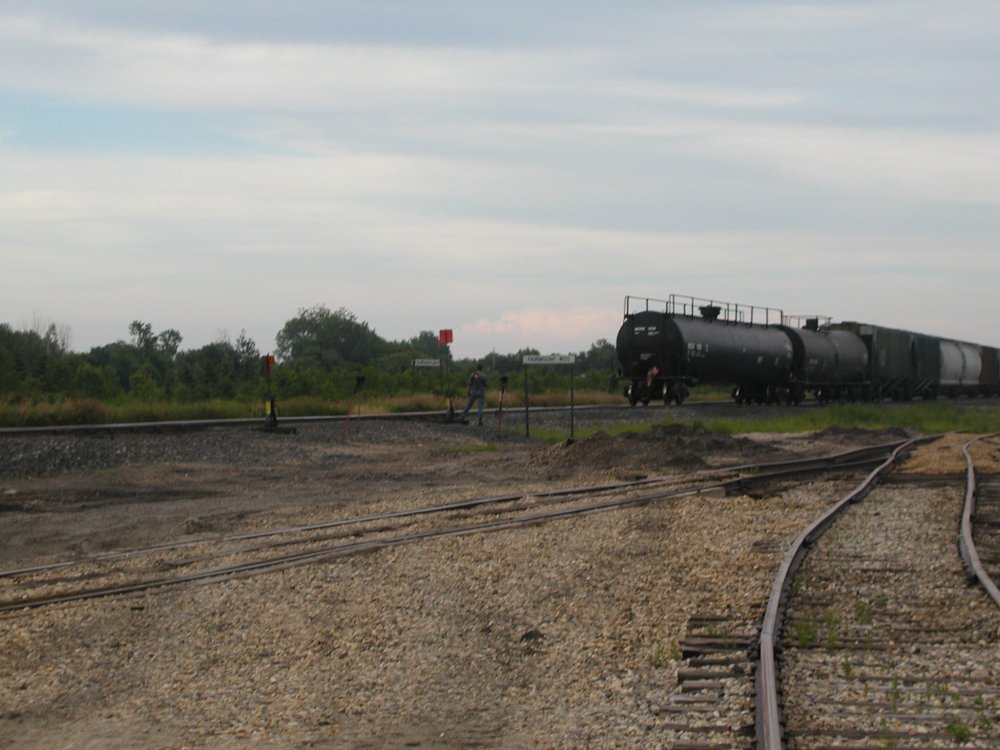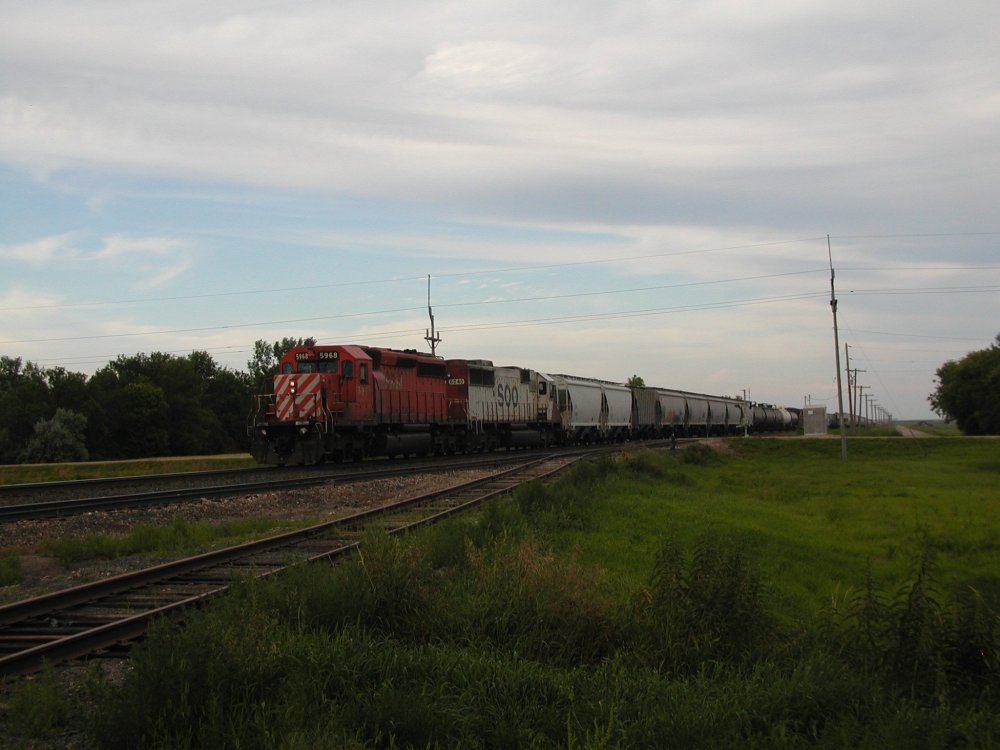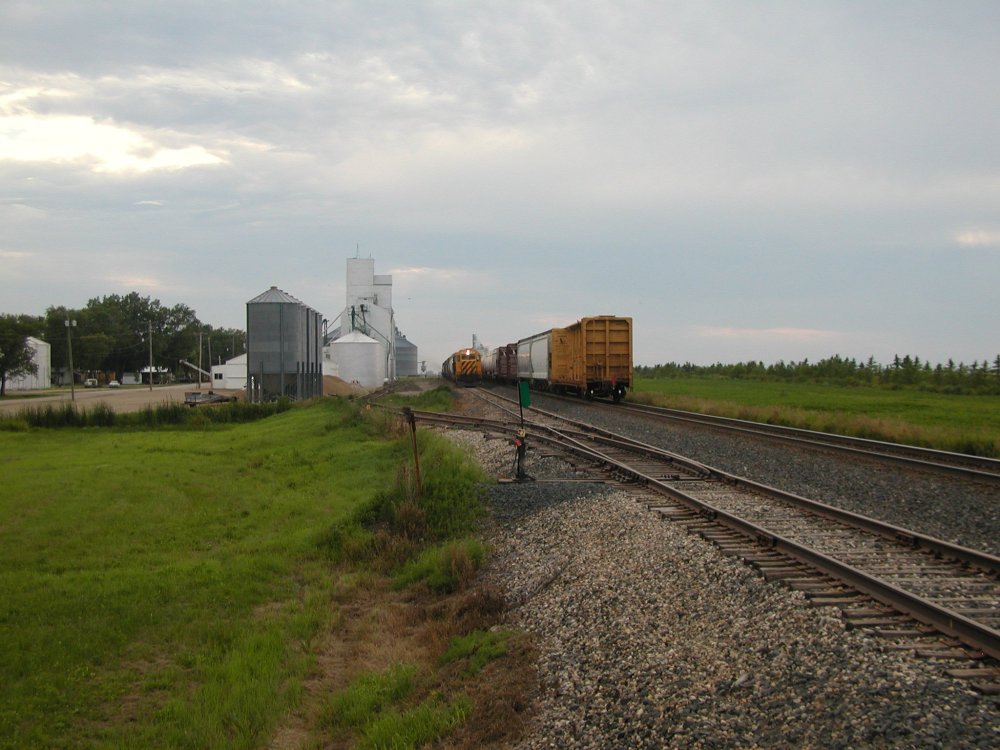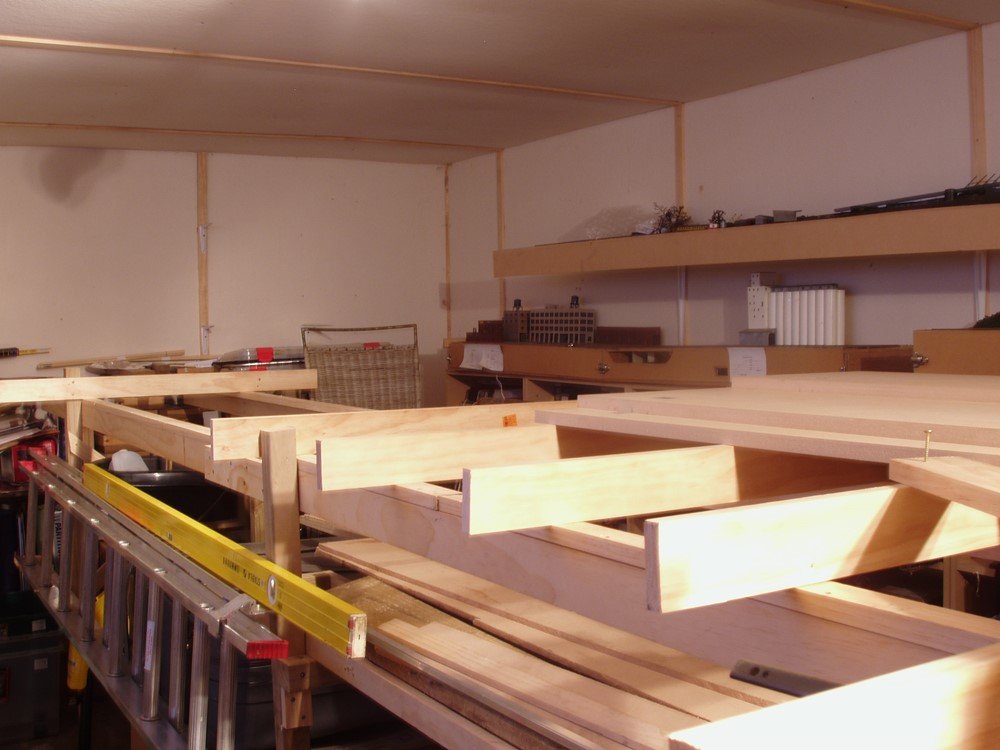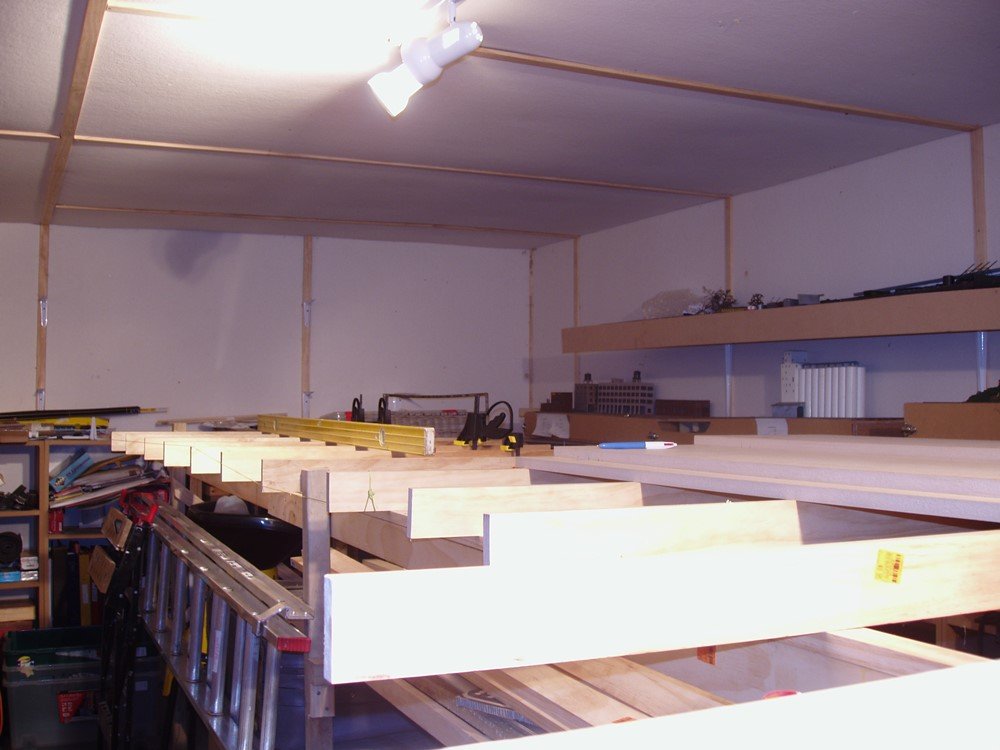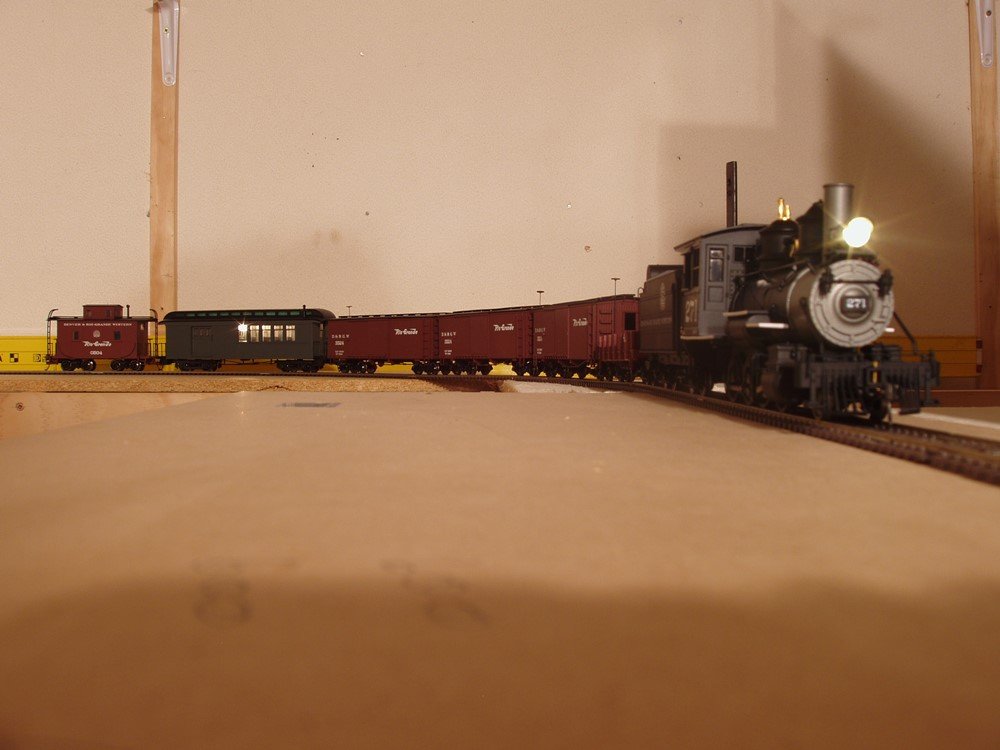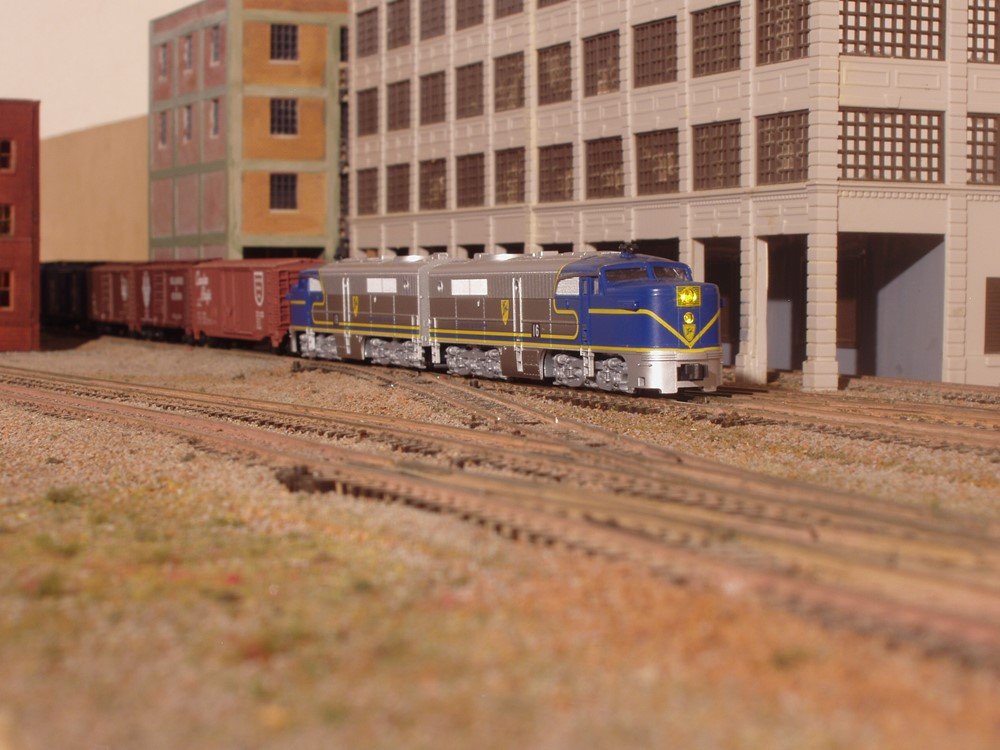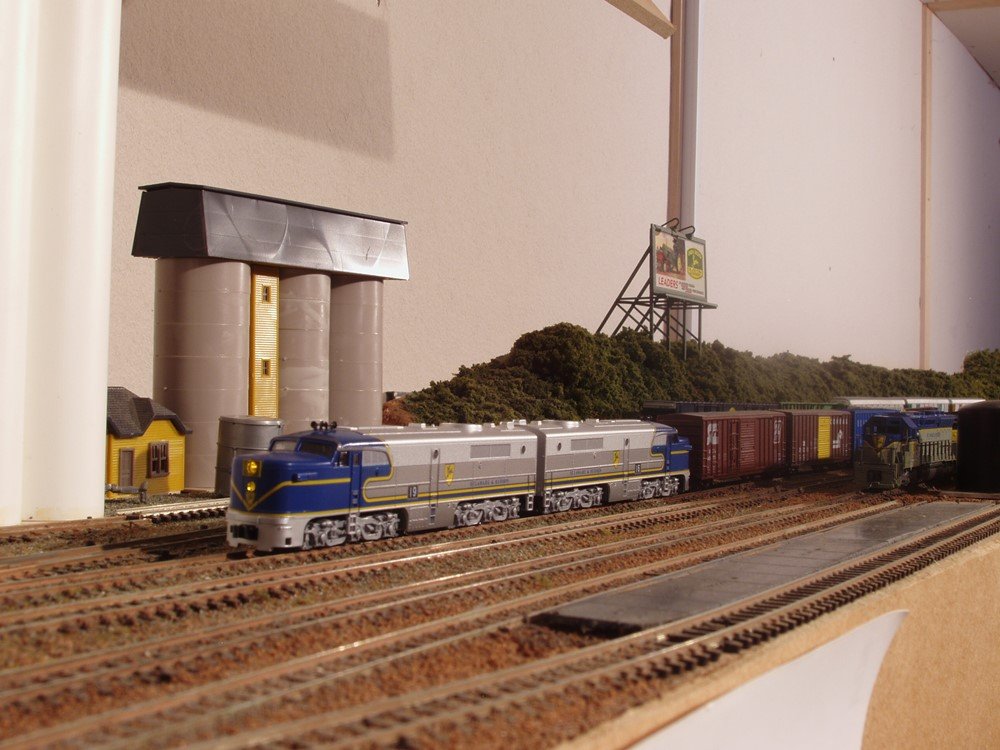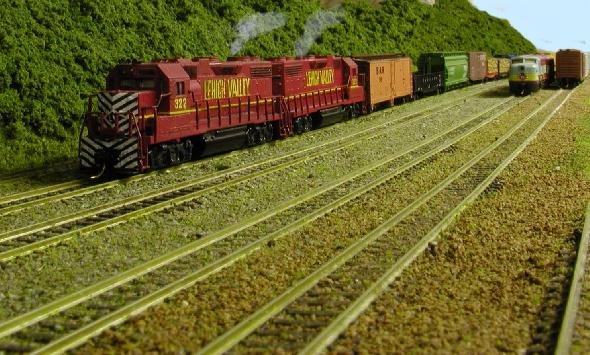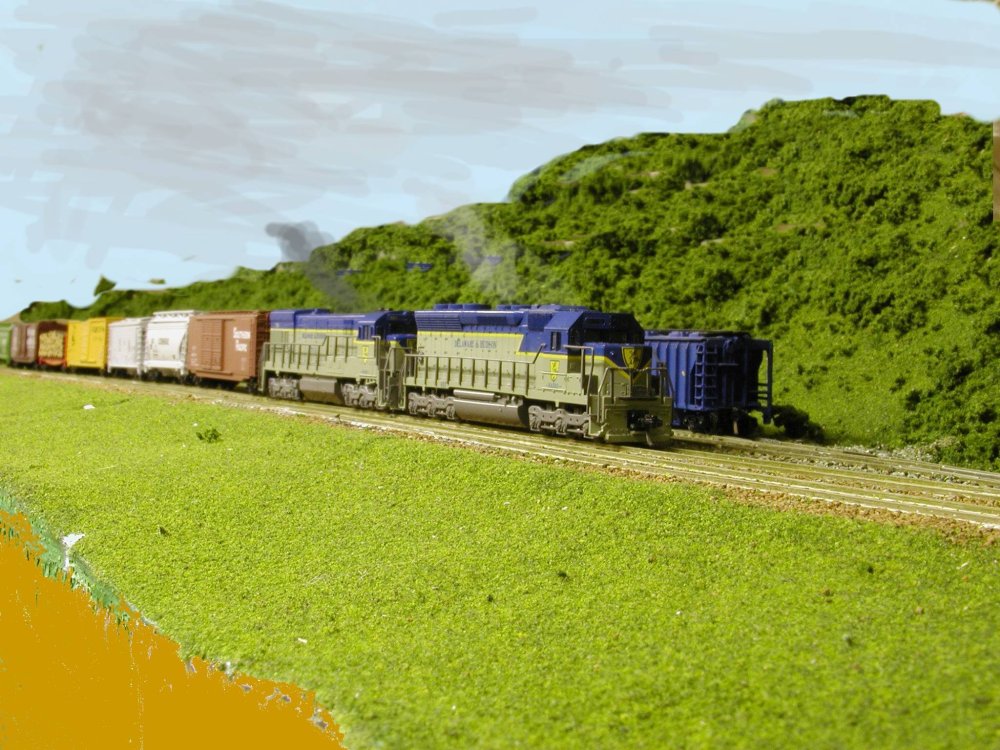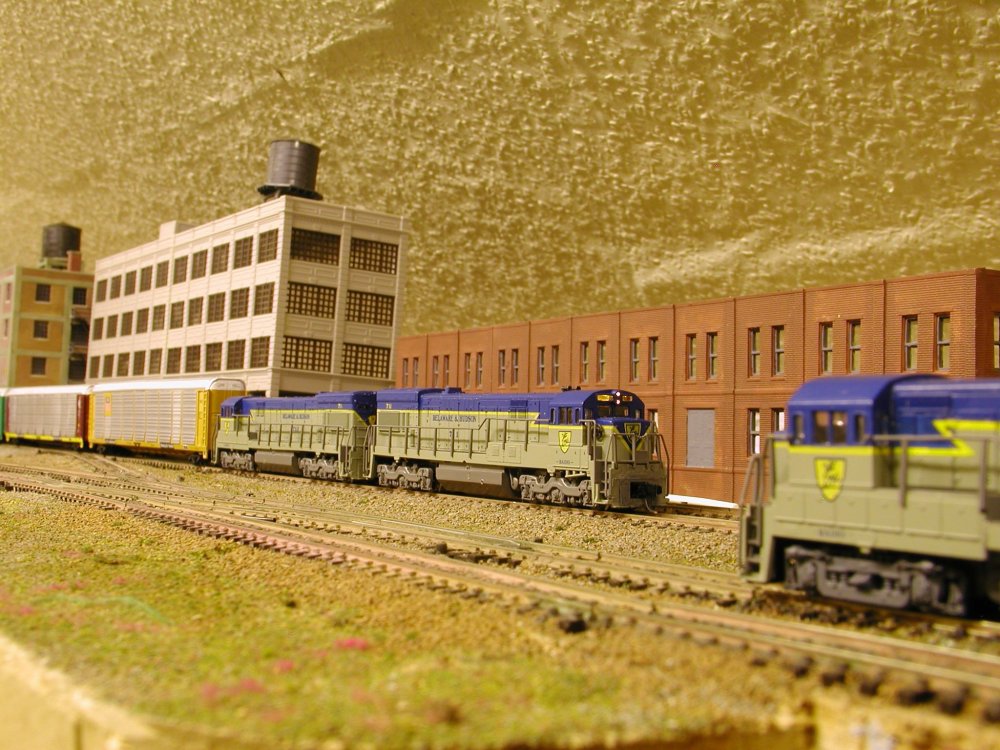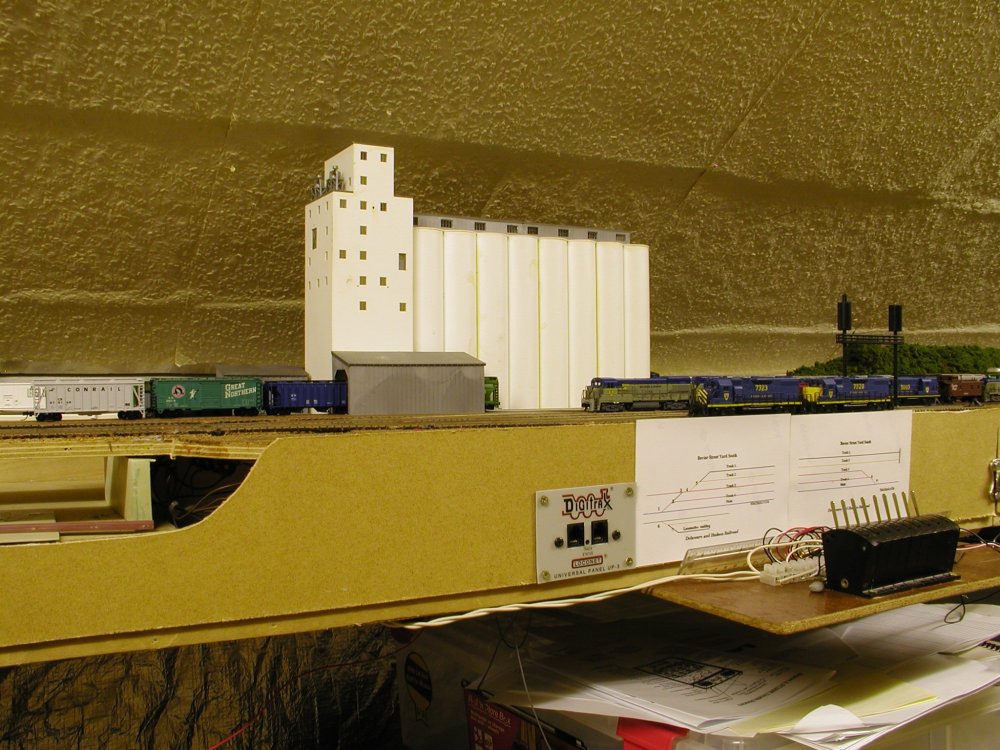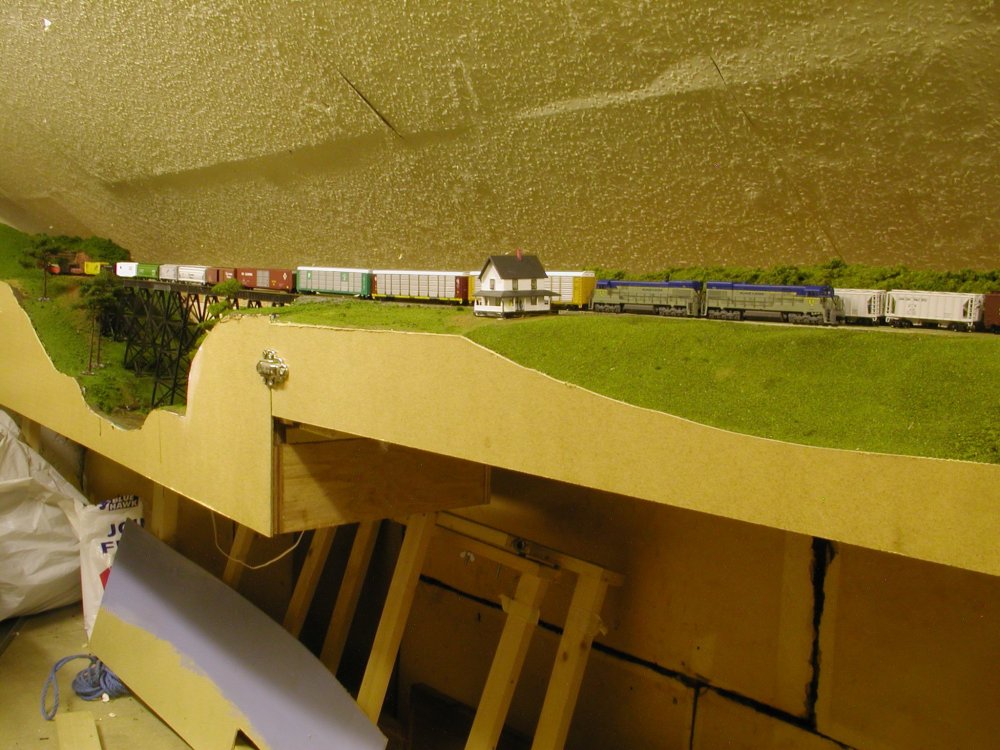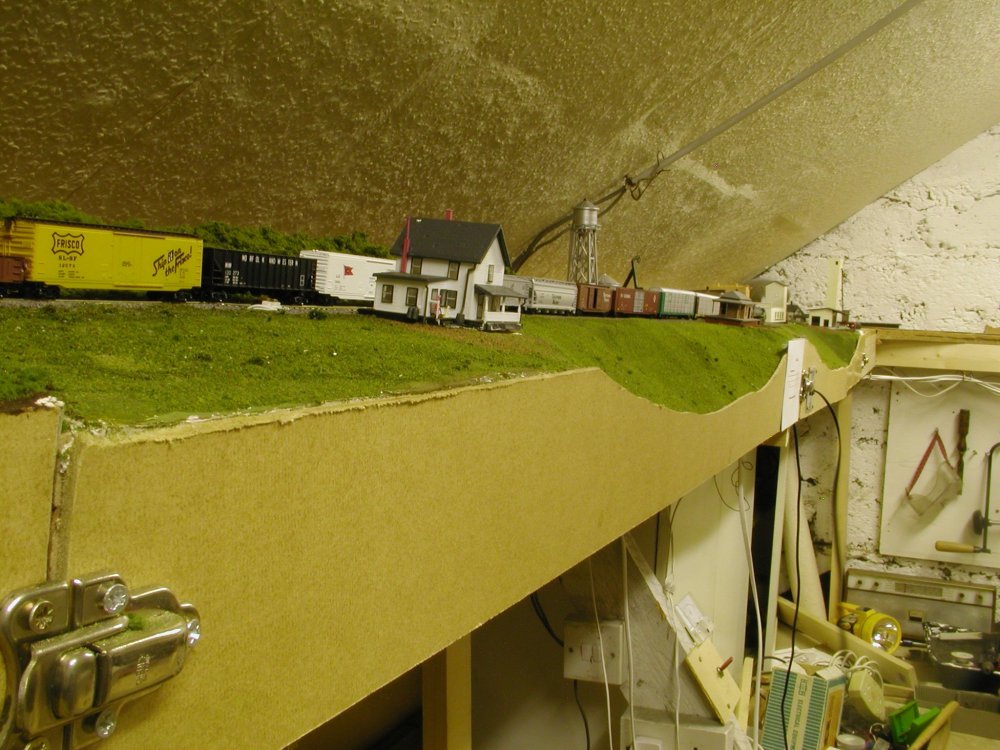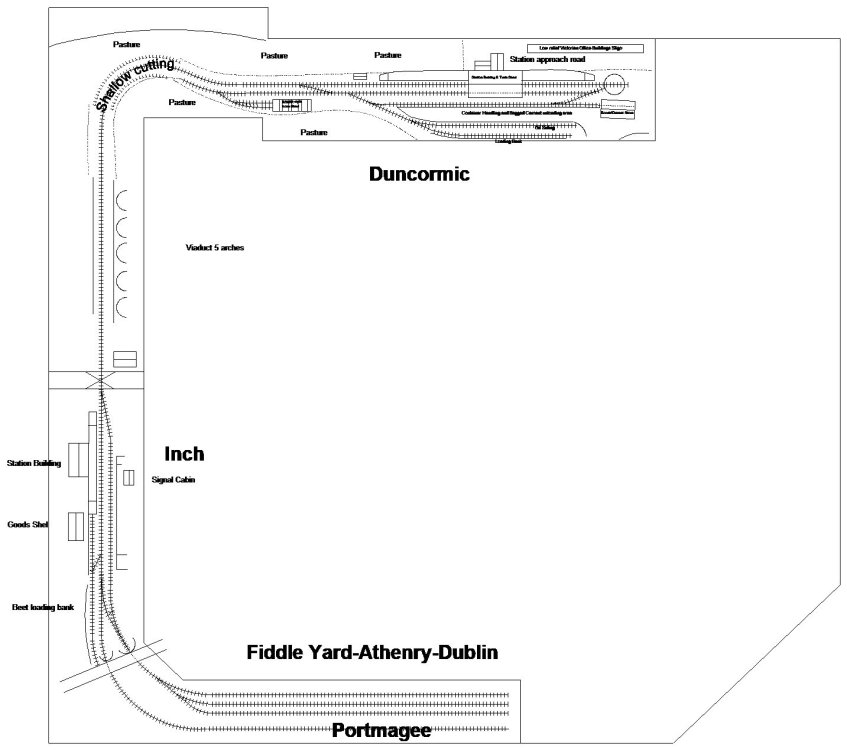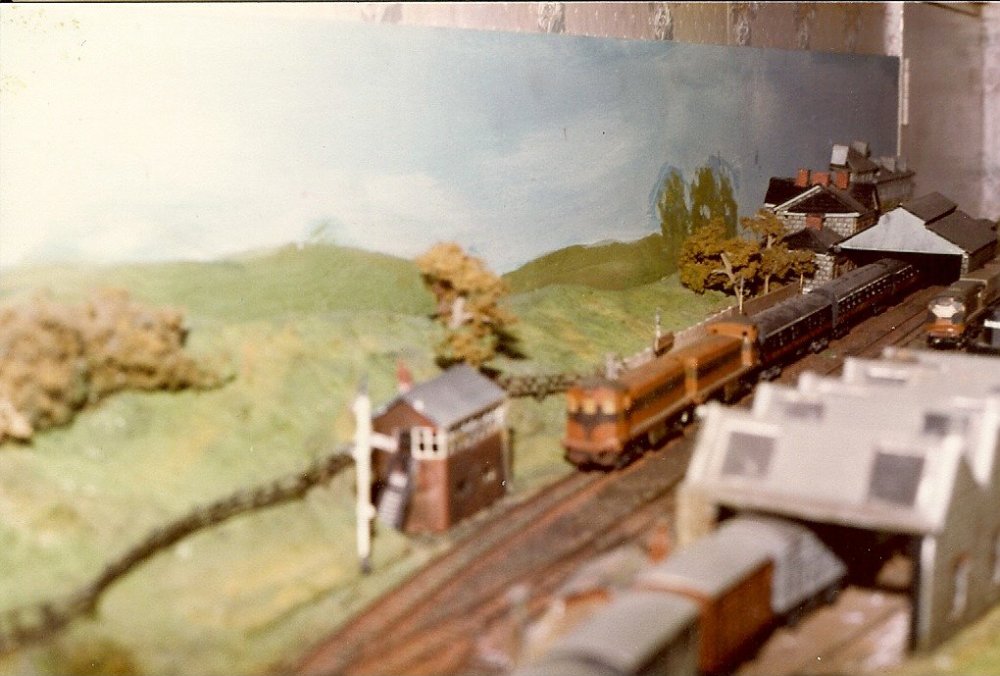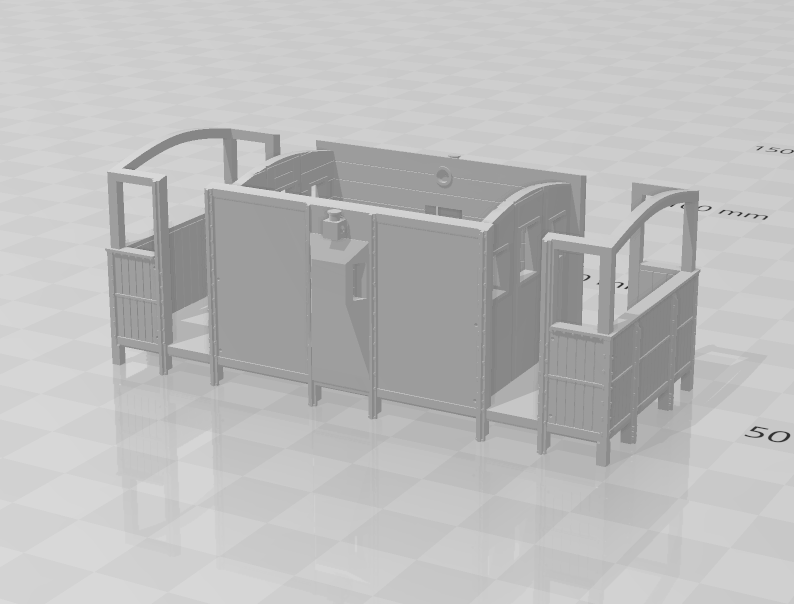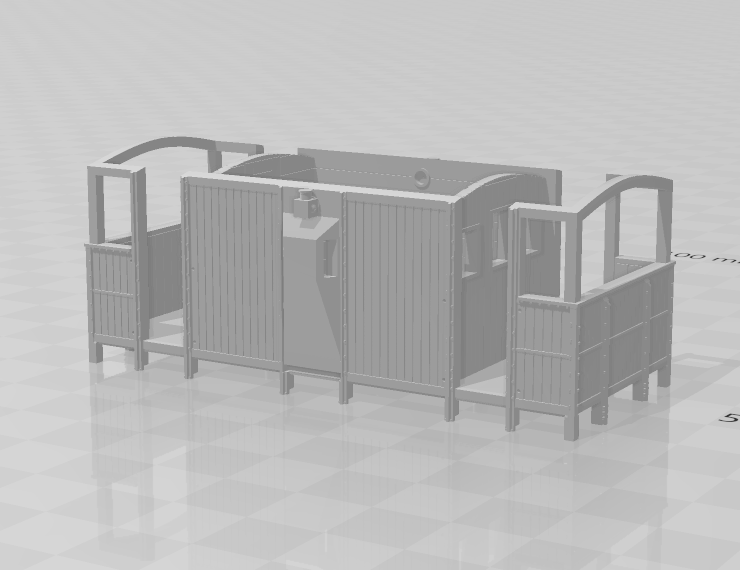-
Posts
4,868 -
Joined
-
Last visited
-
Days Won
119
Content Type
Profiles
Forums
Events
Gallery
Blogs
Store
Community Map
Everything posted by Mayner
-

Narrow Gauge in the Rockies not quite
Mayner replied to Mayner's topic in US / Canadian Railway Modelling
Home from the land of the ice and snow (US Mid West), first job before running trains was to mow the lawn which in some places had grown nearly a foot during the past four weeks and clear the railway of debris/encroaching vegetation Although a dry El Nino weather system was forecast this Summer most of January turned out wet and humid with rampant plant growth and everything saturated. Main yard area covered in debris. Fallen branches tunnel area Vegetation taking over main line area was cleared for train running a coupe of days before Christmas. Ran a couple of trains late afternoon after tidying up garden and clearing railway. Usual drill ran train from staging in shed to main yard, turned locos on Wye and re-marshalled trains for return run before tea time. 346 leading short freight after trimming back jungle. I need to remove creeping plants/weeds that have began to tae over this area. 463 with 8 cars (6 stock, 2 Box) + Caboose on main line. Although within 463s normal capability turned out a challenge to haul this train up the 4% grade with wheels slipping on greasy rails from yesterdays heavy rain. Although the loco made it round the tricky curved section at the bottom of the grade slipped on the more easily graded straight section half way up that was in the shade through out the day, despite several re-starts and opening and closing the regulator ended up assisting with the 0-5-0. You can usually control wheelslip by "twiddling" the throttle speed control knob in a similar manner to closing and opening the regulator on a steam loco to prevent wheel slip. Usually I would have sent a second loco to assist or "doubled the hill" after 463 stalled, but the mosquitos were out and I had the bins to put out for tomorrows collection, running the trains was a nice break from the days chores. Interestingly 348 and its train made it up the grade without slipping but considerable wheel slip! I had reduced 348s train to 4 cars and a caboose to avoid the train stalling. -

Would you model in 21mm if RTR track and models were readily available?
Mayner replied to BosKonay's topic in Irish Models
Quite a collection Dave. I just realised I have a model of 191 I assembled 30 years ago from the TMD J15 kit. I bought a J15 and an S Class kit from Terry McDermott in the early 90s, loco won a prize kit built loco category Milton Keynes Model Railway Club. The TMJ J15 was all brass, I thinned the coupling rods to represent unpainted steel, tender axlebox castings were glued on at the time I hadn't tried soldering whitemetal. There have been a number of changes in the long production life of the kit 1985-date? The original TMD kit was etched in brass (body and chassis) with turned brass frame spacers, chimney and dome, but no castings, later versions of the TMD kit included whitemetal chimney, dome castings and plastic spring/axlebox castings. The body and chassis of the SSM (Paul Greene) version of the kit was etched in nickel silver with a comprehensive set of whitemetal castings. The small GNR 0-6-0 57 was originally produced by Northstar Design (Adrian Rowland) who also produced 7 and 4mm versions of a GNR PP 4-4-0 and a 10mm Scale Tralee and Dingle 2-6-0 which passed on to SSM. There was a transition period between TMD and Studio Scale Models. SSM marketing and selling the GNR 20T Goods Brake while TMD continued to sell its existing stock of Irish loco kits. The GNR compound was initially marketed and sold by TMD after SSM had taken over the marketing and sales of earlier TMD kits (The TMD Compound Kit included the tender from the SSM (exTMD) GNR S Class) The GSR Bredin Coaches may initially have been marketed and sold by TMD before being incorporated in to the SSM range. -
At 139 years Kettering Furnaces No 3 is historic by any standards the sole survivor of the Black Hawthorne 0-4-0ST supplied to the site. No 3 is likely to require substantial work to restore to working order (mechanical re-build and likely a new boiler & firebox) Industrial locos tended to be worked hard in harsh conditions with minimal maintenance compared to locos used on main line and public light railways. The National Trust appears to have approved the donation of the loco to the WSVR who appear to be aware of the challenges and are entrusting the restoration to a an engineering works in the UK that has experience in restoring historic locos. https://www.wsvrailway.ie/news/bus-route-to-kilmeadan-station/
-
Can't help thinking that a new build possibly 0-4-2T would be a better option than attempting to restore a 157 year old 0-4-0ST Apart from the historic significance of Kettering Furnaces No 3 a Black Hawthorne in close to its original condition, an 0-4-2T would be more suitable than an outside cylinder 0-4-0 for working passenger trains on a line line the Suir Valley. Narrow gauge short wheelbase 0-4-0ST have a reputation of being unstable for 'main line" work in Wales the Tallylyn and Corris rebuilt their 0-4-0St as O-4-2ST and the Ballymena Cushendall and Red Bay used Black Hawthorn 0-4-2ST for their Iron Ore trains and were later used for Tourist Traffic. Personally I think static display in a museum would be more appropriate given the age and historic significance of the loco either in the North East or one of the ironstone railway groups in the East Midlands with a established record in restoring steam locos.
-

Would you model in 21mm if RTR track and models were readily available?
Mayner replied to BosKonay's topic in Irish Models
Snap! Three GNR 21mm gauge locos assembled from TMD (Terry McDermott) kits 1996-2002. Locos probably last run on MRSI Loughrea layout during exhibition early 2000s, all three locos require repair and repaint after 20 odd years in storage/on display. One kit bought new from Terry before Paul Greene acquired the business, the remaining locos picked up as part of a job lot of part built TMD kits at a UK exhibition. 174 Caruntuhill possibly the last S Class outshopped by Dundalk in lined blue after the CIE takeover. An S masquerading as Qs 132. Loco is due a strip down and re-paint following damage in storage. Grey overspray on boiler and running board following attempt to clean up smokebox. SG awaiting lettering and numerals following re-paint -
Bit difficult to imagine N I Railways a UK state funded body selecting German RAL (Reichs-Ausschuß für Lieferbedingungen und Gütesicherung) rather than BS (British Standard) colours for its corporate colour scheme. The CIE corporate colour scheme of the 1960s was developed by a Swedish firm of consultants hence the use of a RAL code rather than a BS No for the orange/tan. Might be worth contacting Translink or the Ulster Folk and Transport Museum for a definitive answer.
-
As builder and construction project manager I have serious reservations about the ground level detail of the sheds in Murray's photos. There appears to be a risk or damp and potential failure (rot) of the shed structure in the apparent absence of underfloor ventilation or a dampproof membrane between the ground and the shed one of the underlying principals of building construction. I ended up replacing the timber ground floor with a concrete slab on a dpm in a house in Dublin about 30 years ago as a result of blocked underfloor vents. Personally I would build the shed using timber frame construction either on a suspended timber floor on timber piles or a concrete raft/slab foundation Timber frame construction was and remains the standard for housing construction in New Zealand, I built a scaled down version of a New Zealand Railways platform shelter as a store in our garden. Personally if I was building a replica or a Brake Van or Wagon, I would use 100X50mm treated timber for the structural framing, with treated T&G board or treated grooved plywood for the cladding on a building membrane, with treated 4X1 for the cosmetic outside framing. Internally walls ceilings and underfloor insulated with batt insulation and lined with plasterboard or plywood depending on your taste. Potentially looking at a min 6X2" for floor joists at 16" centres supported on 4X3 bearers to support a couple of people in the shed if you go for a suspended floor. Local building regs. require a min 400mm ground clearance under a suspended floor so potential space if you want to allow for wheels, brake gear and steps.
-

Would you model in 21mm if RTR track and models were readily available?
Mayner replied to BosKonay's topic in Irish Models
GNR "Ford Platelayers Trolley" set of scratchbuilders parts available from Worsley Works for several years. Alan sent me a photo of the fret but I never bought one! The S looks like its built from a SSM kit, I built a couple! Clearances between splashers, coupling rods and crank pins are minimal on these locos in 21mm gauge -

Industrial sites in Ireland with their own locomotives
Mayner replied to jhb171achill's topic in General Chat
Possibly a Pier with its own loco at Dugort Harbour financed by local gentry and Castletown West business interests not unlike Tralee-Fenit,. Tralee & Fenit Harbour Company Hunslet 0-6-0ST "Shamrock" an ex-contractors Hunslet 0-6-0St was taken into GSWR stock and numbered 299 when the GSWR absorbed the WLWR. The Broad Gauge harbour or industrial lines were a bit too main stream for my taste, Irish, reservoir, Quarry/mining and forestry tramways more interesting/challenging Reservoir and Hydro Schemes Another possibility are the standard and narrow gauge railways used in reservoir construction and early hydro electric schemes. Mourn Mountains-----Standard gauge possibly steam worked. Roundwood----------Little information---Rail possibly used in second reservoir scheme in 1920s---Mention of a loco shed. Shannon Scheme----Broad and Narrow gauge--German proprietary equipment--------Possible Ho or Hoe project. Poulaphuca Hydri Electric-----Narrow Gauge---possibly 2'----UK Proprietary equipment Motor Rail (Simplex) or R&H locos--ideally 7mm scale or larger. Mining and Quarrying. Hodgsons Tramway--------3'6" Avoca copper mines to Arklow to 1860s-------- Traction engine style locos 7mm or larger! Quarry tramways---Arklow, Achill---------possibly 2' gauge proprietary British or Greman locos-------indeally 7mm or larger. Benbulbin-Mullaghmore ----------2' gauge Byrytes Tramway mid 1920s short lived 1 Motor Rail possibly War Surplus loco/ Forestry Tramways Glenfarne post WW1 era-----2' Gauge 0-6-0T-WW1 era industrial a 7mm kit may be available -

'Modern' lrish style Apartment Buildings / Houses- OO scale
Mayner replied to Rob's topic in Irish Models
Having worked in construction management in the UK and Ireland for many years there are significant difference in architectural styling and building materials used in public, commercial and residential (apartments & housing), between Ireland and the UK. Differences less significant between UK & Ireland in modern industrial, warehousing and logistics which basically use similar materials and construction techniques. Best source of information are Building Consent/Planning applications which should contain architectural and engineering drawings and specification. Best option is probably to design and produce Irish model building using a programme such as Inkscape https://inkscape.org/. The Buildings and structures on Kevin Sweeney's Ballywillian thread appear to be designed and constructed using Inkscape, WARB's Barrow Street thread features models of modern and refurbished buildings in the Pearse St-Grand Canal Dock area. For me the biggest gaps are absence of Dublin Corporation 3 Bed "Kitchen" and 2 Bed Parlour houses, the typical 'spec.' built Dublin Semi of the 30s, and Herbert George Simms "Art Deco" Corporation Flats of the 1930s, but precious little to do with trains apart from an Inchacore Works Backdrop -
Possibly my last posting from this visit to the Land or Ice and snow before we return to New Zealand. Ice Fishing shelters on the Red River. Popular pastime shelters apparently include home comforts including heating, bedding and beer fridge. 4104 & 2018 switching at Beckenridge. When I arrived 4104 appeared to be preparing to depart with a Westbound freight when in fact breaking down the train by sorting cars to different roads "Flat Switching" or what was known as loose shunting in the UK and Ireland. Once fairly common in Ireland during loose coupled days usually prohibited in the days of Liner Train operation. Loco pushes back against a cut of cars, cars to be sorted uncoupled and allowed to continue under their own momentum after the loco/remainder of the train has stopped. Tank car with snow/ice on barrel is continuing under its own momentum after being uncoupled from the tank cars on the left. Brakeman in high vis is re-setting the cut (uncoupling) lever on the car on the left before preparing for the next cut. The Brakeman used the blue pickup in the background for moving around the yard. 4403 arrives with a short train of tank cars while 4101 waits to make its next move. The tank cars are possibly molasses from a Sugar Beet Plant a couple of miles west of the twin towns of Beckenridge MN and Whapeton ND The Yard God has made a cut between the grey and black tank cars, shortly before 4101 and 2018 put away their train and return to the Motive Power depot. The pick up had similar markings on the other side and tail board! More Coil to make into Bobcats! More D&H Grain Hoppers including a complete shield 34 years after the CP takeover. East end of Beckenridge . Entry to balloon loop to Red River Grain Elevator, tracks with tank and grain cars on right forms a U. Almost like busses Westbound BNSF Shuttle Grain. Two big GEs on head end one on rear, saw a similar train Friday loading at a Shuttle Elevator located on a stub branch of the Ottertail Valley Railroad (Shortline) near Fergus Falls MN.
-
Garden Railway 2008-present. In a way the time line says it all in terms of success almost 16 still in operation 16 years after completing the main running track approx The railway is basically a large oval with three towns or yards on the outdoor section and a branch to storage tracks in the garage/workshop. Although we carried out some miniature plantings and ballasted the track, the railway is primarily operational with few detailed buildings, structures or scenic detailing. Originally starting out as completely freelance using American outline Bachmann and LGB locos and stock the railway is now heavily influenced by the Colorado Narrow Gauge with the original stock replaced by more accurate 1:20.3 scale models. Operationally the most significant development has been the change from DCC track power to on-board battery radio control using RCS (Radio Control Systems) transmitters (throttles) and receivers (decoders). Originally it was hoped to operate the layout using the Digitrax command control system I had used for the N gauge layout upgraded to radio RC operation. The Digitrax command station booster has variable power and voltage settings for N-HO-G with a 5amp 20v a/c output for G/large scale locos, with the layout divided into 2 power districts the Digitrax system was adequate for powering large scale locos, and the Digitrax RC system adequate for speed and function control but reversal unreliable (range and obstructions), it was necessary to plug the Throttles into Remote Panels at towns and yards for reliable reversal. I finally bit the bullet after several years and converted to RCS on board radio control with 100% reliable operation and no longer a need to bother with track or wheel cleaning. There is no real equivalent of Digitrax, Lenz, NCE or Zimo in large scale radio remote control RCS was a 27mh/z system developed by the late Tony Walsingham in Australia largely using Deltang components. now marketed by Chris Drowley in New Zealand. Apart form the high initial set up cost the main draw back of battery RC is limited battery life of the NiMh batteries I use in my locomotives. I am not going to risk a Li Pol battery in a rare high-value ($1000+) Loco or Motor. Biggest challenge is maintaining baseboard structure and track exposed to the elements high humidity, rainfall and UV exposure. The baseboard structure is CCA treated timber using in fencing and decking which has stood up well to constant soaking and drying, but now showing signs of decay in some areas requiring repair/replacement. UV has had a significant impact having had to replace approx, 50% of ties/sleepers on the Accuracraft flexible track used on main and yard trackage after 5 years usage, thankfully the ties used on the Sunset Valley switches/points had a higher UV resistance and their tie strip used in the tie replacement programme. Although I originally intended to create a CTC panel using JMRI Panel Pro and point motors to control the staging and main line switches/points, all switches are controlled by hand using Sunset Valley Vertical Switchstands or Groundthrows generally similar to those used in American full size practice and more in keeping with the Colorado Narrow Gauge. Operation. These days I tend to operate the garden railway occasionally running a train when working in the garden and occasionally running a way freight from the Staging to Jackson City (the main yard) dropping off/picking up cars en-route on Sunday mornings and returning in late afternoon/evening depending on the season! We once had an active Garden Railway Group in the region with monthly visits to each others homes and railways, but largely became defunct inactive as group members passed on, left the area, the cost of travel or lost interest in model railways. We reached a peak in terms of operation 3-4 years ago with regular operating sessions using a car routing system which kept 2-3 operators busy though largely ceased pre-Covid. Garden railway modellers tend to be largely from an older demographic, I am the second youngest member of the group at 67 our youngest member finds it difficult to find time for modelling as a result of the pressure of work and rearing a family. Although retired I am finding it difficult to maintain our property or find time for modelling as a result of caring responsibilities and the effects of age. Perhaps its time to consider focusing on one modelling project, possibly returning to N Gauge while I am still able?
- 9 replies
-
- 12
-

-
20 years earlier and a bit warner. We spent six month in the Mid-West during the summer of 2004 en-route to New Zealand. Back then there was a lot more variety in terms of motive power and company liveries on the CP line across MN & ND. The line was classed as 'Dark Territory" with train movements on the Elbow Lake Subdivision controlled by "Track Warrants" (TWC) issued by radio by a Dispatcher based at Hankinson, a modern streamlined version of Train Order and Telegraph, no fixed signals and and hand operated switches at Sidings (crossing places). An advantage of TWC was that railfans could listen in to communications between Dispatcher, Train and Maintenance Crews and predict 'what was coming". The Line was upgraded to CTC during the mid 2100s to cope with increased traffic. CP 9004 leading a consist of leased power heads a eastbound grain train through Fairmount ND. 9004 is a SD4-2F a cowled variant of the 3000hp SD40-2 design built for CP during the late 1980s. Oldest of Fairmount's 3 grain elevators on left flour mill in right background. A pair of CP ex SOO Line GPs leading a westbound Way Freight (pick up goods) on the siding at Nashua MN Aug 2004. Nashua was a regular location for setting up meets (crossings) between opposing trains on the Elbow Lake Subdivision, with no grade crossings trains could wait in the siding for an indefinite period without the requirement to divide the train after 15 minutes to avoid obstructing road traffic. The switches at both end of the siding were hand operated, train crews departing the siding usually asked the Dispatcher for permission to leave the switch set for the siding and "switch set for siding" noted in Warrant for next approaching train. Eastbound mixed freight crossing Westbound Way Freight lead by 8545 at Nashua. 8545 is an GS AC4400CW (4400HP) trailing loco is a CP formerly SOO formerly Milwaukee Rd SD40-2 "Bandit Loco" retaining the remains of its ex Milwaukee Rd Livery. Westbound way-freight passing Fairmount. The lawn and vegetable plot were the gardens of a dilapidated old two storey house near the location of the diamond between the East-West Soo and North-South Milwaukee line, track curving round on the right is an industry track which serves a fuel and fertiliser store. Once carried in box cars covered hoppers were introduced in large numbers for grain traffic during the 1980s. Anatomy of a train meet at Fairmount. 1. Eastbound Red River and Valley and Western Hankinson job accelerates along the 'main' at Fairmount after switching the flour mill in the background. The RRVW Caterpillar powered GP20-C could produce some nice smoke effects while accelerating. Relatively short freight by US standard, main and crossing track maintained by CP, yard tracks by local industries! 2. RRVWR Hankinson Job pulls up to the Siding Switch while a Westbound CP freight waits on the Main at the East end of Town. The RRVWR freight is preparing to pull into the siding to clear the main for the CP train. 3. RRVWR train has pulled up clear of the siding switch, brakeman has set the switch for the main line and the RRVWR crew calling the CP Dispatcher to confirm the switch has been set for the main and the main line is clear. 4. CP 5960 leads Westbound trough freight into Fairmount. 5960 a 3000hp SD40-2 is fitted with dynamic brakes for use on heavily graded lines, 6040 is an ex-SOO Line 3800hp SD60 dynamic brakes not really required on the relatively easily grade ex-SOO lines. 5. Meet between RRVWR & CP Freights at Fairmount. As far as I recall the RRVWR freight set back along the siding to pick up the brakeman once the CP freight cleared, avoiding a long walk (for the brakeman) over rough ballast! The shape of things to come! Single GEs Dash 9 and Evolution series (4400hp) locos handling the majority of CP freights on the ex-CP line
-
Delaware and Hudson Mk 2 N Gauge Auckland 2006-7 Our 1st home in New Zealand had a 24X12 garage ideal for conversion to a model railway room 1st thoughts were to build an O Scale American narrow gauge layout mainly using Bachmann's recently introduced On30 locos and stock rather than returning to N Scale while building a minimum space (8x1) shelf layout in the home office to get something up and running quickly. I had hoped to build a scenic On30 layout with a central peninsula in the garage to maximise the length of run and maximise the scenic effects using American L Girder Baseboard framing for the peninsula board and conventional baseboards on top of MDF storage units around the walls. Christmas 2005. Garage converted to a layout room with insulation board wall and ceiling linings. Showing L Girder baseboard under construction L girder 2X1" horizontal glued to 3X1 vertical member, and 3X1" bearers, the peninsula was supported by 3 pairs of 2X2 legs the legs also supported a timber rack. Bearers installed, Binghampton Modules in background. The peninsula end had a dumbell shape with the baseboard widened to allow the track to turn through 180° with a central view blocker down the centre of the peninsula. Mock up of L Girder risers and track sub-roadbed. L girder construction is used primarily for open top baseboard construction with track base ideally ply supported on risers allowing for realistic scenic effect. Mock up of Ophir section of Ophir Loop on peninsula with view blocker down centre of baseboard. Track at this stage set up as return loop final version would have run down opposite side of view blocker/backscene. Mixed Train with Broadway Limited C16 and Bachmann cars. At this stage I decided to abandon an On30 layout and substantially expand the N Scale D&H layout or much the same reason as I decided to abandon OO and model in N over 20 years earlier although I had substantially more space. The On30 stock although underscale did not work visually on the mock up and tended to dominate the available space. I had sold the trestle and small town module before moving to New Zealand, incorporating the downtown Binghampton and one of the yard modules into the new layout. extending the yard onto a permanent section of the layout with a 180° curve to link up with the staging which was at a lower level than the scenic baseboard. The main additions at this stage were a pair of Kato PA1 diesels and a pair of Amtrak P42 locos and a Walthers Coal Depot (typical of the North East) Technically the greatest change was the introduction of route setting between Binghampton Yard and the Staging using JMRI (Java Model Railway Interface) making its possible to set up 'routes" on a home computer or laptop (to control stationary decoders) rather than using the Switch function on the throttle, at the same time Radio replace Infrared wireless control and additional throttles were added. Temporary tracks. In much the same way as the On30 mock up track was laid temporarily on sheets of MDF to test the operational capability of the layout before installing permanent trackbase and track. Peco N gauge track and points are very forgiving of this type of treatment. Move of home and change in modelling direction 2007. We moved to Hamilton in 2007 as a result of a career change which in turn lead to a change in modelling direction from N to Garden railway modelling in G Scale on 45mm gauge. We were fortunate to find an interesting house on a classical Kiwi ¼acre section something increasingly rare as a result of intensification and redevelopment in urban areas. The N scale went into storage as I focused on building a garden railway, our garage was smaller than in Auckland and required extensive renovation. Although the Auckland layout was dismantled, the L Girders and legs support my workbench and a timber rack. I used most of the baseboard framing in Auckland in the base board framing for a new layout in Hamilton which is nicely seasoned almost 20 years storage. The main challenge at this stage is finding time to build a layout.
-
Delaware and Hudson American N Gauge folded 8 layout Dublin 2000-2004. I lived and worked in London and the Home Counties from the Mid-80s to the Mid 90s and seldom lived in the one place long enough or had the space to build a medium size layout. I converted the attic of our house to a layout room following my return to Ireland and finally got around to building a layout during the late 90s initially a folded 8 test track to run my collection of American outline locos and stock and eventually got around to building a 'permanent layout" around 2000. Although I was mainly interested in modelling Irish railways, I got hooked on American N gauge and the Delaware and Hudson after a couple of visits to Victors model shop and browsing Charring Cross Road bookshops and soon amassed a collection of American locos and stock, which I occasionally ran on a circle of track while living in a shared house or later in my own apartment. At the time American N scale was especially attractive Atlas had outsourced loco manufacture from Roco and Rivarossi in Europe to Kato in Japan and the quality of the models and running quality improved significantly with fine detail, die-cast chassis, centrally mounted skew wound motor driving all axles and later twin flywheels and low friction bogies/trucks. I choose the Delaware and Hudson because of the attractive livery/appearance of the Atlas RS3 model and discovered that a D&H would be an intersting railroad to model a small Class 1 (Large Railroad) that had an interesting loco fleet and carried heavy freight traffic on scenic and heavily graded routes in Upstate New York and Pennsylvania. The test track was to get things up and running quickly and test the running of long freight trains. The baseboards were scrap material, ripped down veneered chipboard panels from old fitted wardrobes topped with insulation board from old attic lining. Trains ran well proving it was just about possible to run a 50 car freight using stock retrofitted with Microtrains trucks and or couplings (N Gauge Kadees), attempts to run longer trains were not too successful couplings separating with a loud bang but no physical damage to the coupling or cars. Decided to replace the test track with permanent running tracks on conventional (timber frame and chipboard) baseboards fixed above purlin level around the attic with removable scenic sections on ply baseboards which connected to the permanent staging/hidden trackage. Earlier I had built a 7'6" X 1' N gauge modular layout on the One Track principal to fit in our box bedroom, future modules were 4X1 wired for DCC operation in accordance with N Trak recommendations. The scenic section of the layout is based on the D&H Susquehanna Subdivision that carries heavy traffic between the North East (Canada, New England), the East and South East (New Jersey, Pennsylvania & Virginia) and the West (Buffalo and Chicago) on a scenic heavily graded route through Up State New York. The principal feature of the layout is a model based on the downtown area and old D&H yard in Binghampton NY with its industries, and yard. An important interchange point for freight traffic between the North East, West and East South where motive power was changed, trains reversed or re-marshalled. The remainder of the scenic section represents the single track D&H Main Line with the 'Helper Section" from Binghampton Yard to Belden Hill Tunnel, a typical Susquehanna Division steel trestle and a small Town with Passing Track or siding. The scenic section baseboards are 3/8" wbp plywood the original downtown/loco yard module conventional ply baseboard top, the remaining sections featured open top baseboard framing with ply track base. Control was DCC using a Digitrax Empire Builder (2000) with "walk around" wireless control using infrared capable throttles and receivers, an additional Empire was added, used as a booster, the railroad divided into 'Blocks' protected by digital circuit breakers to prevent a short shutting down the entire system. Switches/Points in the Binghampton Downtown/Loco Yard area controlled by a bank of Triang Black (passing contact) Levers to represent an area controlled by a Mechanical Interlocking/Cabin, Switches at the 'North End" of Binghampton Yard, the Passing Track and Staging were operated by Lenz Stationary decoders controlled by the Throttle to represent CTC or hand operated switches. I used Seep Point Motors to power the switches in the downtown/loco yard area, Peco Point Motors on the remainder of the layout. I developed a sequence for operating the layout based on D&H Train symbols during the mid 1970s with a selection of general merchandise and intermodal (piggy back trains). Through freights were generally operated by 3 Co Co diesels or 4-5 Bo Bos, I sometimes used a Pusher (Baldwin Sharknose) to assist trains from the yard to the Passing Track before returning. In practice running the main-line through freights and turning-remarshalling trains kept me busy, seldom having time to switch the downtown industry tracks or the industry at the Passing Track. We had a few operating sessions with 2-3 visiting operators, who generally preferred to run-trains around as fast as possible Scaletric style! Dismantled the layout when we moved to New Zealand in 2004, shipping and re-erecting the yard and downtown section in the garage of our new home in Auckland planning to incorporate the modules into a larger layout with central peninsula before a move to Hamilton a house on a ¼ acre section and a smaller garage, resulting in a shift from N to Garden Railway modelling. West Bound freight in the Yard wooded hillside acts as a view blocker for the hidden staging. North bound freight departing yard. Trains arriving and departing the Downtown area. Elevator and loco staging area Open baseboard framing trestle area Northbound freight with Autoracks & Auto Parts boxcars crossing trestle, cement hoppers for local industry on spur in background. Freight passing "Dorothys House" on advantage of American N is the availability of a good selection of kit and 'made up" typical buildings in this case a typical early 1900s farm or suburban house.
- 9 replies
-
- 10
-

-
There is an old saying that the only constant thing is change. Forecasts of the demise of the hobby with clubs struggling to host exhibitions in large expensive venues, retailers and manufacturers going out of business is nothing new and has been a feature of the hobby for at least the past 50-60 years I was a member of clubs in Ireland and the UK that had to switch from large expensive venues like the RDS to smaller venues as a result of falling visitor numbers and fatigue during the 1980s and 90s. Prominent UK model railway retailers like W&H and Model Railway Manufacturing (Kings Cross) went out of business during the 90s, Beatties a major UK chain of Model/Hobby shops failed during the early 2000s. The history of the large toy companies that dominated British RTR model railway manufacture up to the early 2000s is like a soap opera of bankrupcies, takeovers and mergers. A sector once dominated by Hornby-Triang-Hornby vastly expanded following Kader (Bachmann UK) entry to the market during the early 90s and increased competition from newly emerging 'Commissioners and specialist Model Railway manufacturers like IRM, Accurascale with the emerging of Chinese OEM manufacturers prepared to undertake smaller production runs that the big toy Chinese companies. Irish Railways had a poor image and a thing of the past while I was growing up in Dublin during the 60s and my parents hoped that 'I would grow out" of my interest in toy trains as a teenager, but I remained undeterred. In New Zealand the hobby tends to be organised more around conventions were modellers get together to play trains, host and attend workshops and visit local exhibitions rather than exhibitions which tend to be more low key and smaller in scale than the UK. Conventions rotate between cities so although there is a lot of work involved in the organisation there is usually a break of several years before a convention returns to a city or town. http://www.nzamrc.org.nz/
-
There is no guarantee that IRM or Murphy Models will be around in 10-20 years to provide warranty support. The history with the big toy makers and warranty support is not great Airfix went bust within 4 years of launching its Airfix Model Railways later GMR range in 1976, Palitoy dropped it Mainline Model Railway range in 1985 after the parent company General Mills pulled out of the European toy market. Hornby/Triang/Hornby had a history of bankrupcies/takeovers and management buy outs from the 1960s to 90s. The other issue is with todays short low volume production runs its unlikely that the 'manufacturer' will hold a stock of spare parts after its settled its 12 month warranty claims. I have had to manufacture replacement parts for a number of high value ($1-3000 (US)) large scale locos as the manufacturers have exhausted their stock of spare parts. Mazac rot is a well known problem with Hornby and Heljan locos. Bachmann's "lifetime limited warranty" applies to motorised units only and allows Bachmann to repair or replace a unit at their discretion. "Items less than a year old are fully covered and will be serviced or replaced at no charge when accompanied by a warranty card or proof of purchase" A service charge applies for repairs or replacement of items more than 1 year old.
-
The containers may have been a low cost alternative to replacing the 'Brown Vans' once used for York-Road parcel traffic with more modern vehicles. Similarly CIE sometimes used its side door containers as vans during the transition from loose coupled to Liner Train operation during the late 70s. It looks like the NIR containers were only used in Northern Ireland, with Red Star parcels conveyed in BR Passenger and Parcel trains between Stranraer-Glasgow and points on the Mainland. Interestingly BR transhipped Railfreight traffic to Northern Ireland from rail to road at Stranraer Stockton Haulage depot. https://www.railforums.co.uk/threads/stranraer-freight-traffic.162202/
-
Over the years I built several layouts some were successful and some not so successful. What's makes a successful layout is pretty much a personal thing, for me it seems to be the ability to get something up and running reasonably quickly, operate reliably and maintain the illusion of realistic operation with trains going and coming from somewhere. Two of my most successful layouts were in N, the a large scale (1.20.3) garden layout, a few 4mm end to end terminal to fiddle yard layouts were marginally successful although they operated reasonably reliably in never completed the scenic or detail works as I had basically lost interest. Duncormic N gauge end to end 1979-1982. Probably one of my best and most complete layouts, built in my bedroom while living in my parents house in my early 20s the layout was dismantled following a house move and never re-erected. I changed to N gauge out of frustration with my attempts to build a OO gauge layout in the box room of our home and to build Irish steam and diesel locos on rtr chassis. Inspired by Brian McCann's Bagnalstown layout and Chiltern Green the reasoning was that it would be easier to build a layout that met my requirements in N than OO and that I would be less tempted to attempt to attempt to scratchbuild/kitbash or modify N Gauge locos and stock to resemble Irish locos and stock. The first part was true in that I found it easier to build a more realistic looking (to me) layout in N than I could achieve in a similar space in OO, the second part was false as it wasn't long before I began modifying British and American rtr locos to look like Irish locos and re-painting/kitbashing stock. After a false start with a single track continuous run layout on an 8X2' folding baseboard based on Kilmessan Junction, I shifted to a U shaped end to end shelf layout around the walls of my bedroom with a medium sized terminus and a small junction station inspired by buildings at Foynes and Ardfert on the North Kerry line transported to County Galway. The terminus and fiddle yard were capable of handling a double headed 5 coach passenger train or a 15 wagon goods on a 5' baseboard something that would be difficult if not impossible to achieve in OO. Duncormic was supported on the bedroom fireplace mantle piece, , Inch and the fiddle yard on aluminium shelving brackets, the curving section supported by the timber cleats fixed to the fireplace recess. the viaduct section was removable (across the window) supported by the Inch and Duncormic scenic board. Baseboards were chipboard with a 2X1 fixed flat to the outer edge, not sure if I got around to fixing fascias. Track and points were Peco Streamline fixed to cork underlay and loosed ballasted Woodlands scenics fine ballast, rails may have been misted with rust using a cheap aerosol airbrush. Points were powered by H&M point motors operated by passing contact switches mounted on a control panel together with section isolating switches. Scenic profiles were on a cardboard framework with 2mm sheet expanded foam to form the ground contours, dyed medical lint ground cover/grass with Peco lineside fencing and Woodland scenics foliage as bushes and hedging. Building were based on drawings and sketches of the stations and one of Patrick Shaffery's Irish Building books. Background buildings at Duncormic were based on commercials buildings from Sligo. Constructed mainly in plasticard, stone buildings with embossed plasticard overlays, the good shed originally from Kilmessan overlayed with plasticard. Windows were clear plasticard with glazing bars and framing drawn in black ink using a drafting pen. I usually operated the layout on Sunday mornings before lunch with a sequence of a pair of 121 Class on 2-3 daily Intercity trains to Dublin, a 141 going in and out with Day and Night Mail connections and a 001 on the goods. Modelling the transition era I had enough wagons to model the loose coupled or Liner Train era, to add variety Inch handled Beet during the season and the branch to Port Magee occasional Beet Trains not unlike Fenit. I had enough shortened Lima Freight Liner wagons to run a Liner, a train of Peco 35T Tank wagons for a 3 a twice weekly Oil Train and 6 Bagged Cement (plasticard bodies on Farish chassis). When running Liner trains the area around the loco shed sidings were used for storing redundant H Vans typical area. Locos and stock were a mixture of Irish and British outline including 121s modified from Atlas SW1500, 141 plasticard body on SW1500, A Class plastciard body on Arnold GP30 chassis (with Lima Brush Type 2 bogie side frames) Cravens coaches re-painted Minitrix (complete with B4 Bogies looked the part when viewed from the compartment side) BR Van and Bogie Brake modified Lima (smaller profile than Minitrix coaches). Misc wagons modified Farish and Lima 4w Container Wagons, Guinness Flats, Bagged Cement, Farish BR wagons re-skinned with plastciard and microstrip as H vans and timber bodied vans. General view Duncormick. Early 70s era 4 coach Black & Tan passenger set at platform. Wagons positioned for loading/unloading in yard. Controller is a H&M "Executive" unit powered by the 15V a/c output of a Safety Minor at the next station. Remarkable resemblance in the positioning of buildings to my 4mm Keadue narrow gauge layout built over 30 years later! Late 70s era. Pair of 121s on Dublin Passenger, B141 on a Liner. Redundant wagons stored out of use in loco yard. Camera was a Kodak Instamatic Was thoroughly enjoyable when it lasted.
- 9 replies
-
- 10
-

-

-
In a way North Dakota is home away from home the wife's father still lives in the family home. At one stage we had planned to stay a year, though appears less likely as we all grow older. Today was trip to a hardware store and for groceries. Once South East North Dakota was crisscrossed by railroads with the SOO Line and Great Northern running parallel to each other for about 40 miles serving the same towns until the GN abandoned its line in a trackage rights agreement during the 1950s that now allows RRVW/BNSF to serve towns on the CPKC (Soo Line). Fairmount a small town close to the Minnesota Border was served by four railrailroads with 4 depots east-west GN & SOO Line, north-south Milwaukee Rd Otronville-Fargo Line and shortline Fairmount and Velben. These days the CPKC line and part of the Fairmount and Veblen survive as successor of SOO Line, the Milwaukee Line abandoned during the 1980s a short section survives to serve a fertiliser and fuel depot. Classical wooden elevators at Tyler once served by the Milwaukee Rd Fargo Branchline. The elevators were later clad in sheet steel but retain tar shingle roofs. The modern grain bins and drying plant are likely to have been added after the railroad was torn-up. Grain likely to have been loaded into boxcars through the side doors fitted with paper 'Grain Doors" when the railroad was in operation "moving grain 40' at a time" Timber battens/boards exposed in area of damaged wall cladding. Timber elevators were usually clad in timber weatherboard. It looks like sawn timber battens/boards were used as a substrate for fixing the sheet metal cladding when elevators were-re-clad. Pair of GP20-C rebuilds and an SD70 outside the Yard Office loco repair shop at Beckenridge. The GP20-C are based on 1980s rebuilds of GP20 locomotives introduced approx 64 years ago, the SD70 is about to perform an interesting duty. GP 38-2s 2015 and 4001 about to depart with a westbound freight. The SD70 in the previous photos has taxied 2015s Crew to their train, crew buses or taxis are often used to transport US train crews from the depot or sign-on point to their train. Coil car in consist most likely for the Bobcat plant at Gwinner. A pleasant surprise was several ex-Delaware and Hudson grain cars in the train. The D&H a Canadian Pacific 'fallen flag" a North-Eastern road had a small fleet of red grain cars which eventually found their way to the RRVW and appear to be used for traffic between elevators and terminals on the RRVW system. There ware at least 4 ex-D&H cars in the train including some with intact shield and logo 34 years after the D&H was absorbed by the CP.
-

Running Numbers of CIE 20T Brake Vans with steel duckets.
Mayner posted a question in Questions & Answers
I am looking for photographs and running numbers of 20T Brake Vans rebuilt with plywood body cladding and steel duckets or an updated version of the JM Design Van I have photos and running numbers of a number of vans which retained their vertical planking when re-built with steel duckets. These vans should cover the period from the late 1960s until the replacement of loose coupled goods trains with fully fitted Liner Trains during the late 70s, a number of 30T Vans were retained for seasonal beet and engineers trains into the 1980s.-
- 2
-

-
Unfortunately no photos, Containers on York Road-Larne parcel trains were basically used as vans loaded and unloaded through a door on one side at least from the early 1980s. There may be photos of parcel trains at Larne in the IRRS Flickr collection, Jonathan Allen's excellent collection of photos of Northern Irelands railway no longer appears to be accessible on line.
-
I replaced the Black Beetle power bogie wheels with smaller Lowmac wheels. I don't know if Steam Era models still manufacture Black Beetle power bogies. Tenshodo appear to produce a 24.5mm wb bogie with 10.5mm dia wheels (approx. 2'7") which should be suitable for a small inspection car. https://www.scalelink.co.uk/acatalog/Sundries---Motor-bogies.html
-
Its just about possible that B121s hauled green ex-GSWR 6 wheeler. B121s apparently worked Galway-Tuam trains between turns on Dublin (Westland Row)-Galway passenger (Mail?) trains during their 1st year of operation, for a short time crews apparently turned the locos to run 'long hood' forward. (IRRS Dublin meeting early 1980s) Galway-Tuam trains appears to have been worked by ex-GSWR 6w stock up to and during the early CIE era, mix of 6w and bogie stock during the 50s. From mid-50s Tuam trains appear to have been a couple of Bredin or earlier Bogies and pair 6w vans. Its just about possible a depot like Cork could put a rake of green 6wheelers together for a seaside excursion to Youghal. The B121s were initially introduced on less demanding duties such as mail, slow passenger and goods and only rostered to more demanding Top Link duties such as the Enterprise after they had proven their reliability and capability in service. Apparently it was once considered allocating the 121s to the K rather than B power classification as they had a lower power output and tractive effort than the B101 Class.
-
Studio Scale Models produced a more modern version of the Drewry Inspection car that fits on a Tenshodo or Black Beetle motor bogie
.png.c363cdf5c3fb7955cd92a55eb6dbbae0.png)

